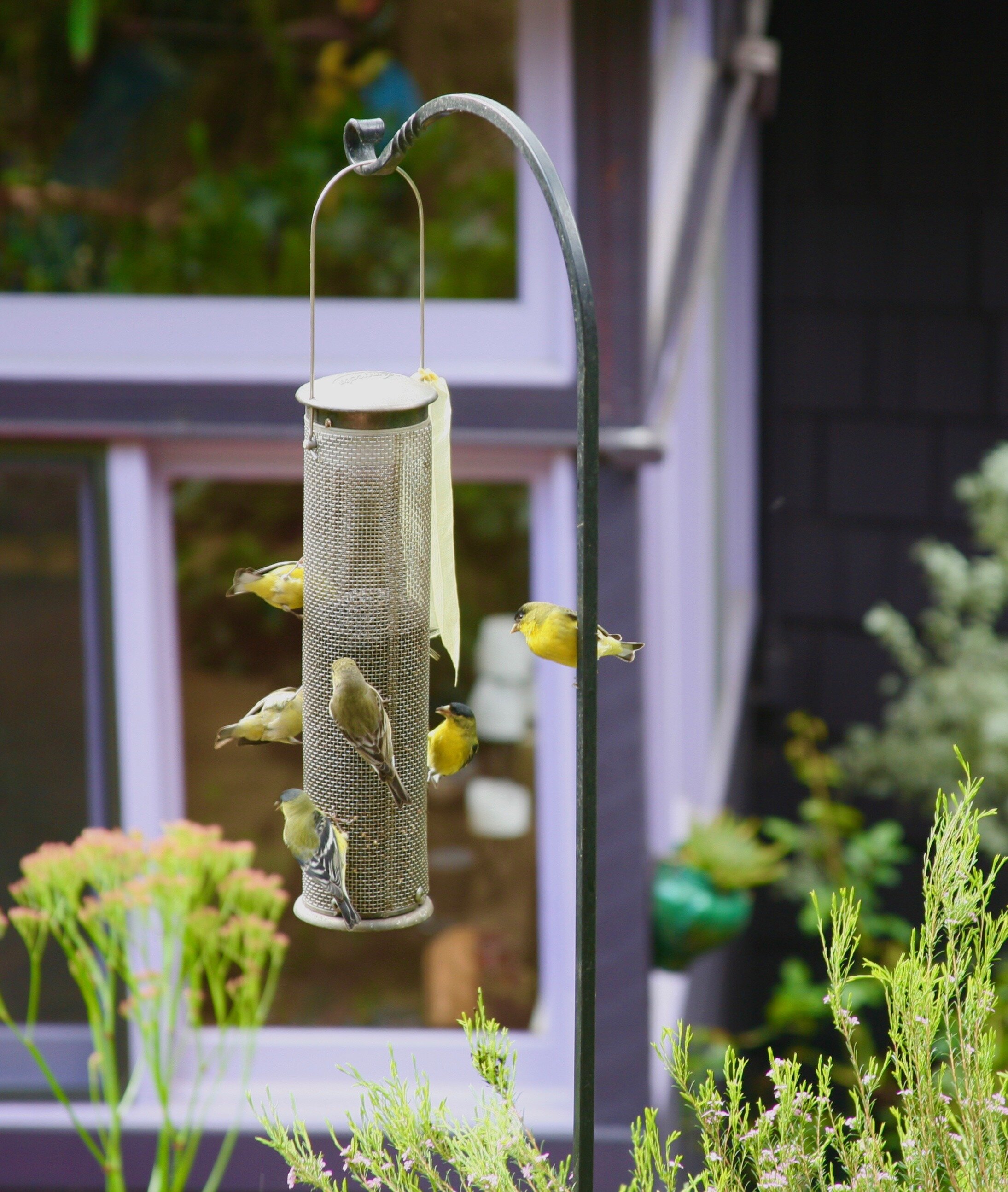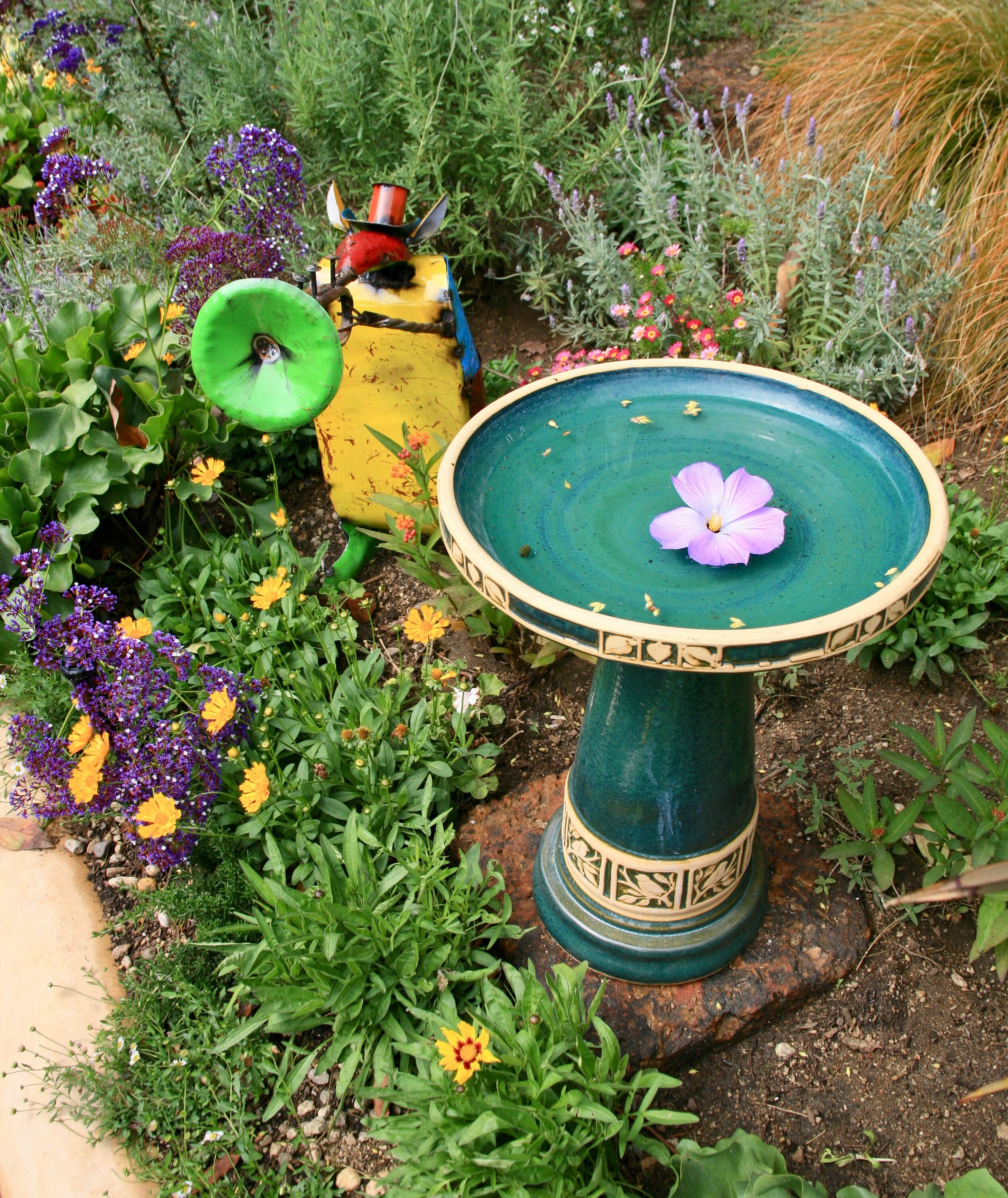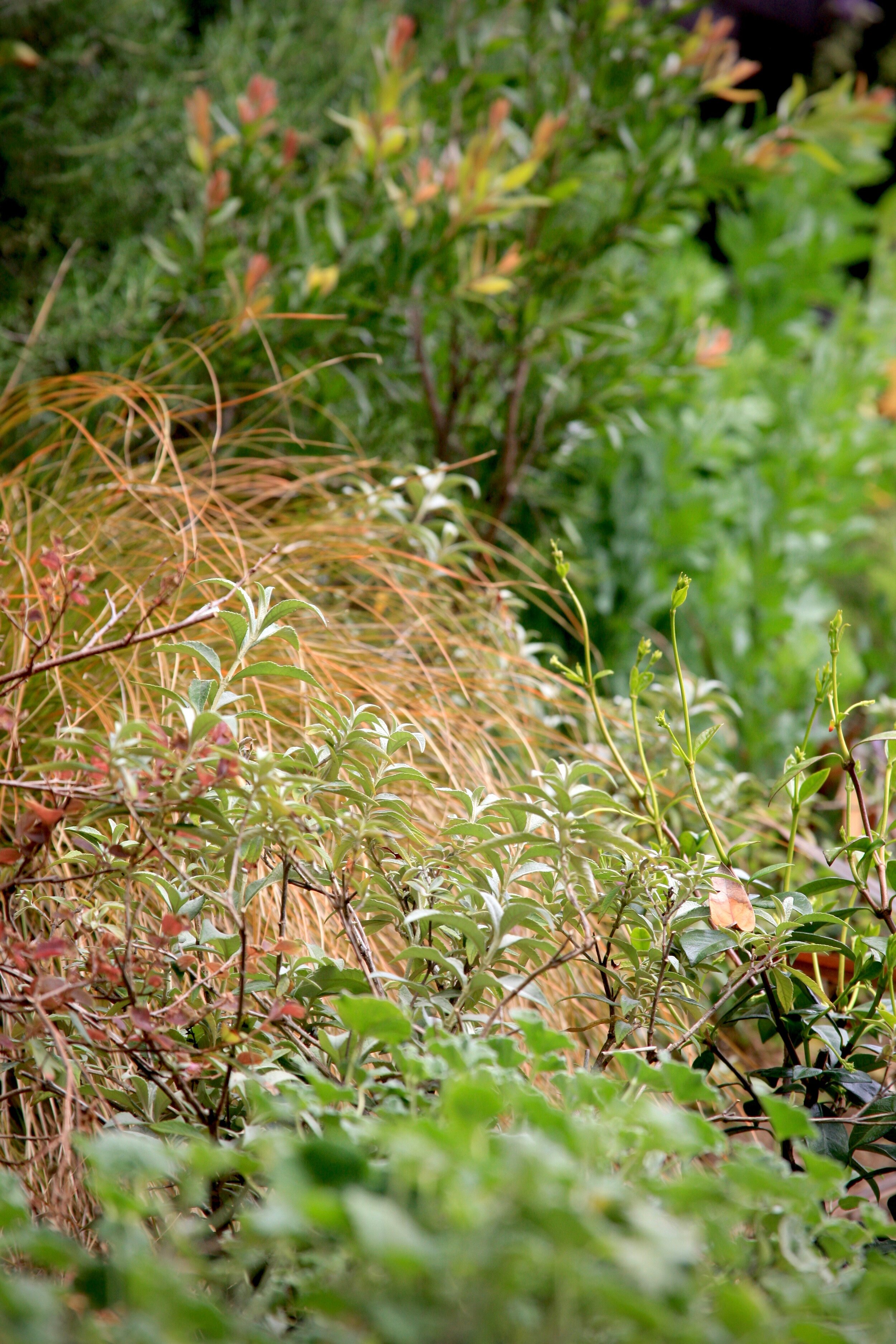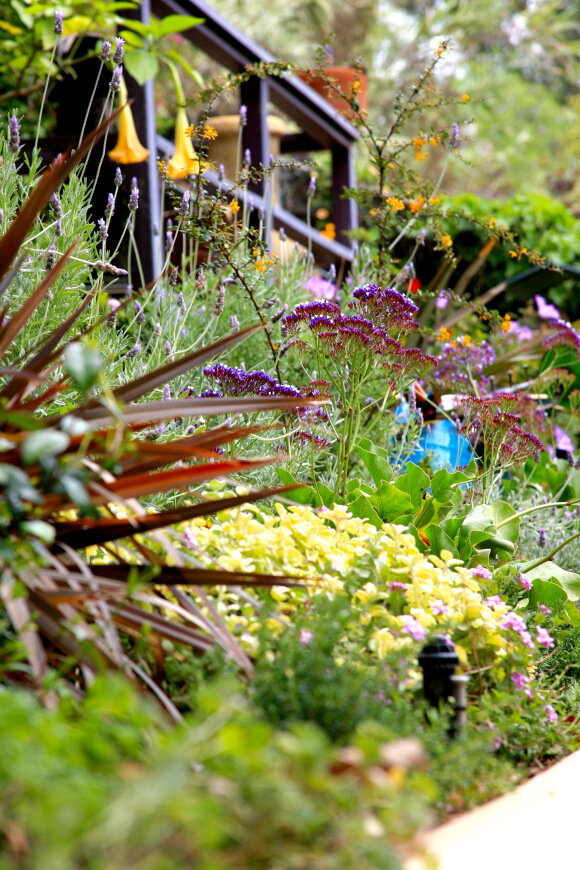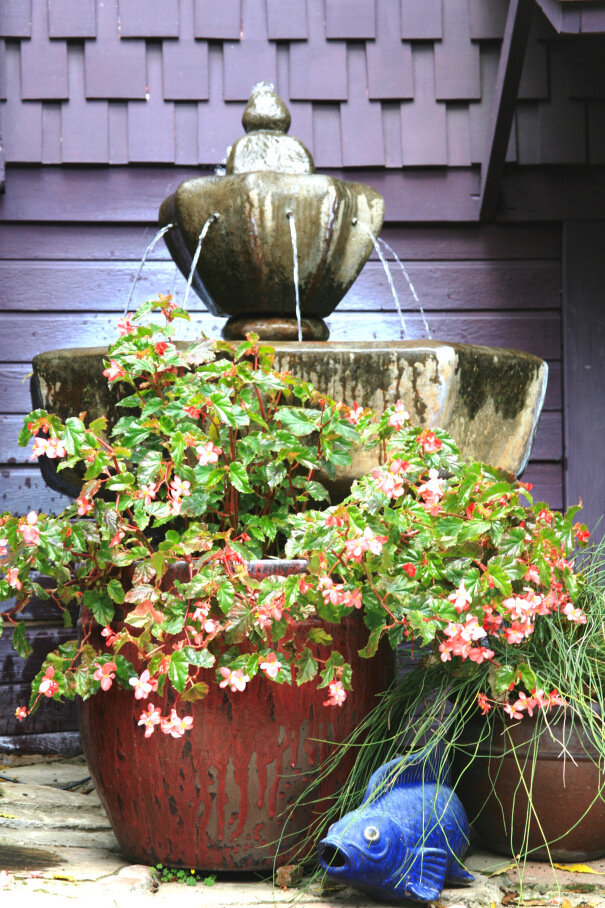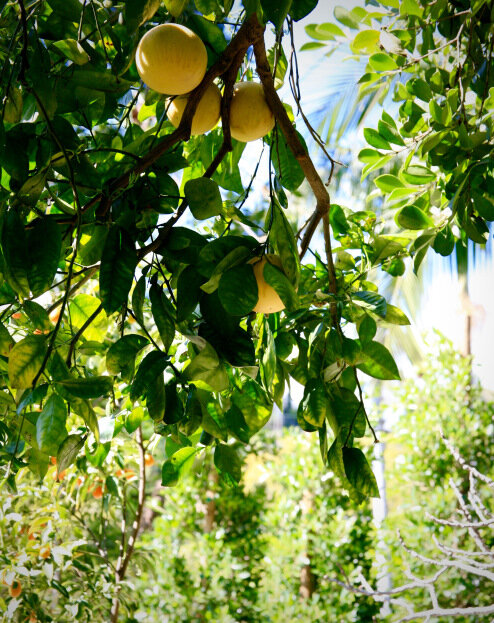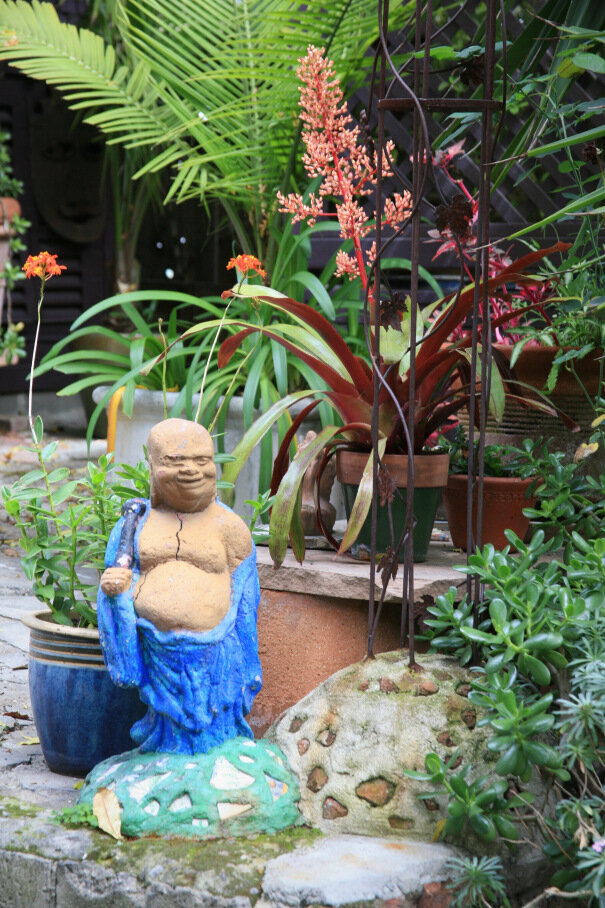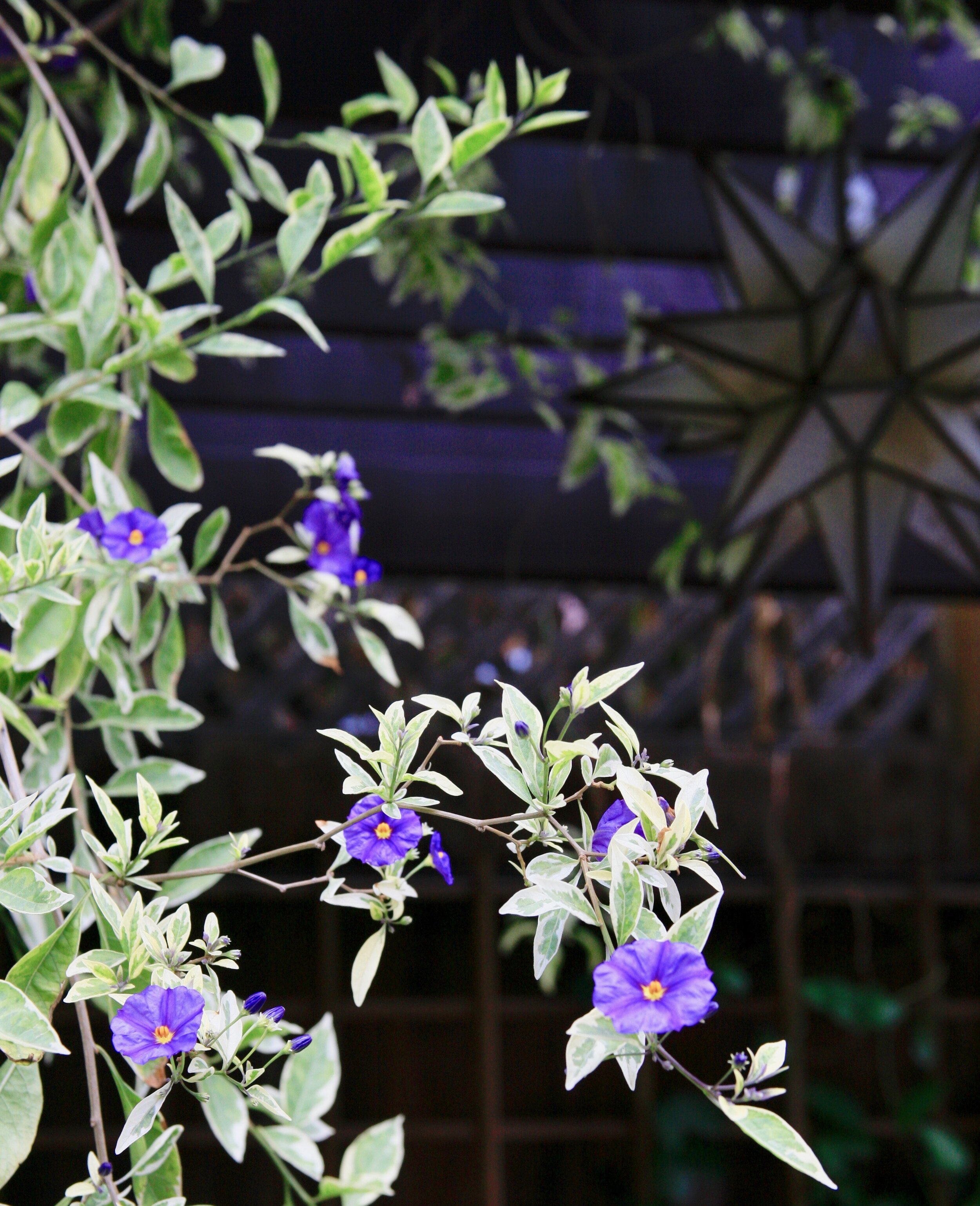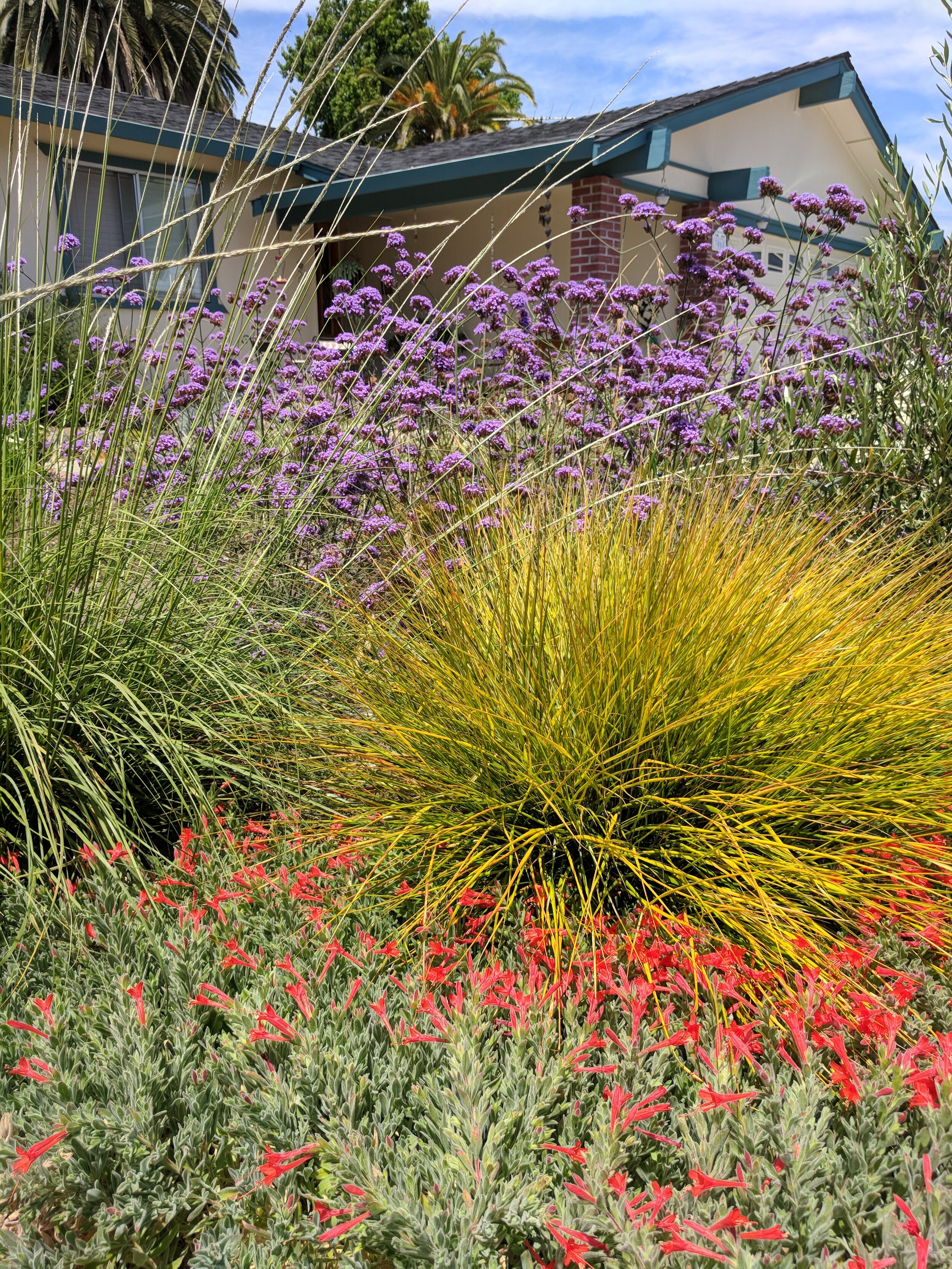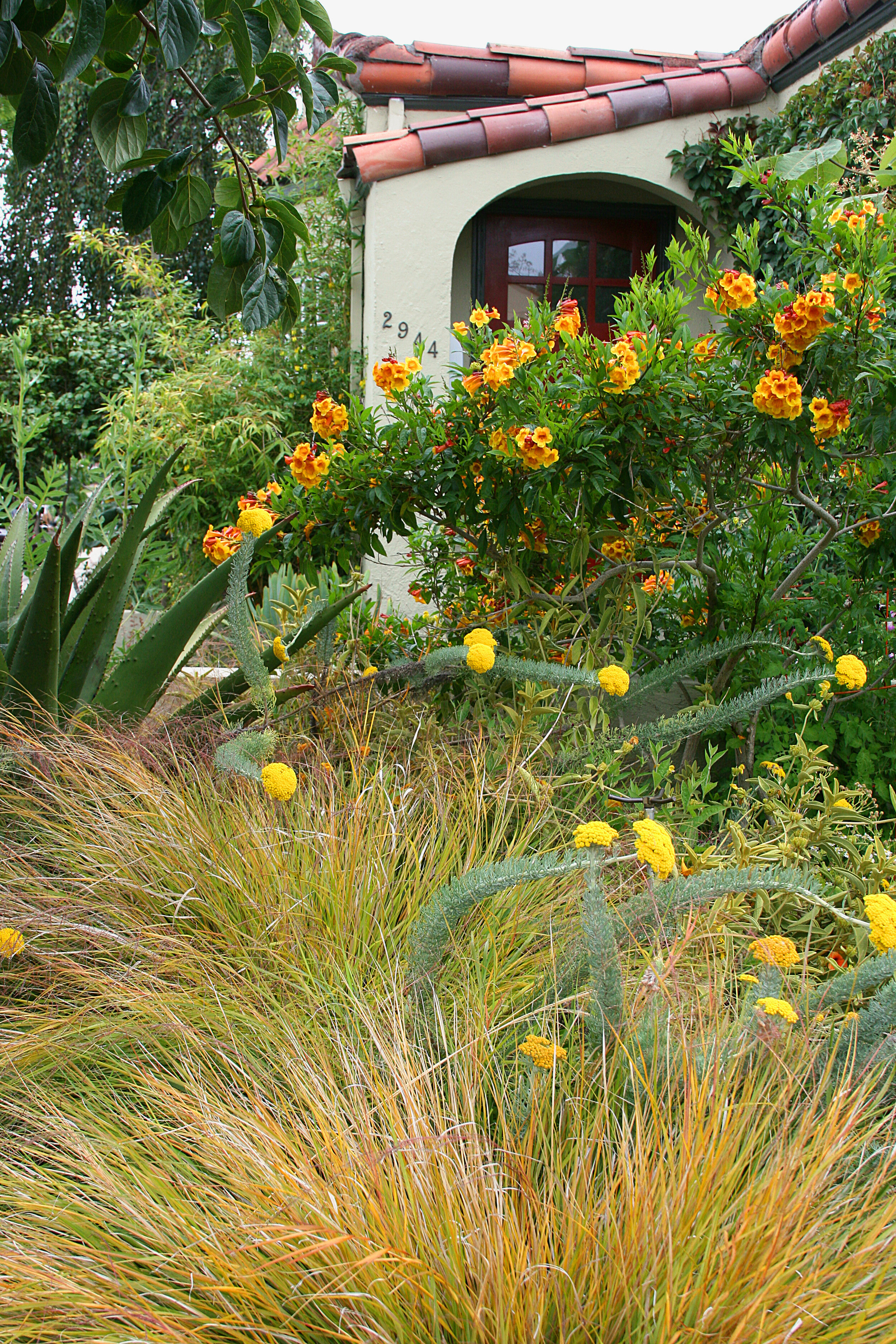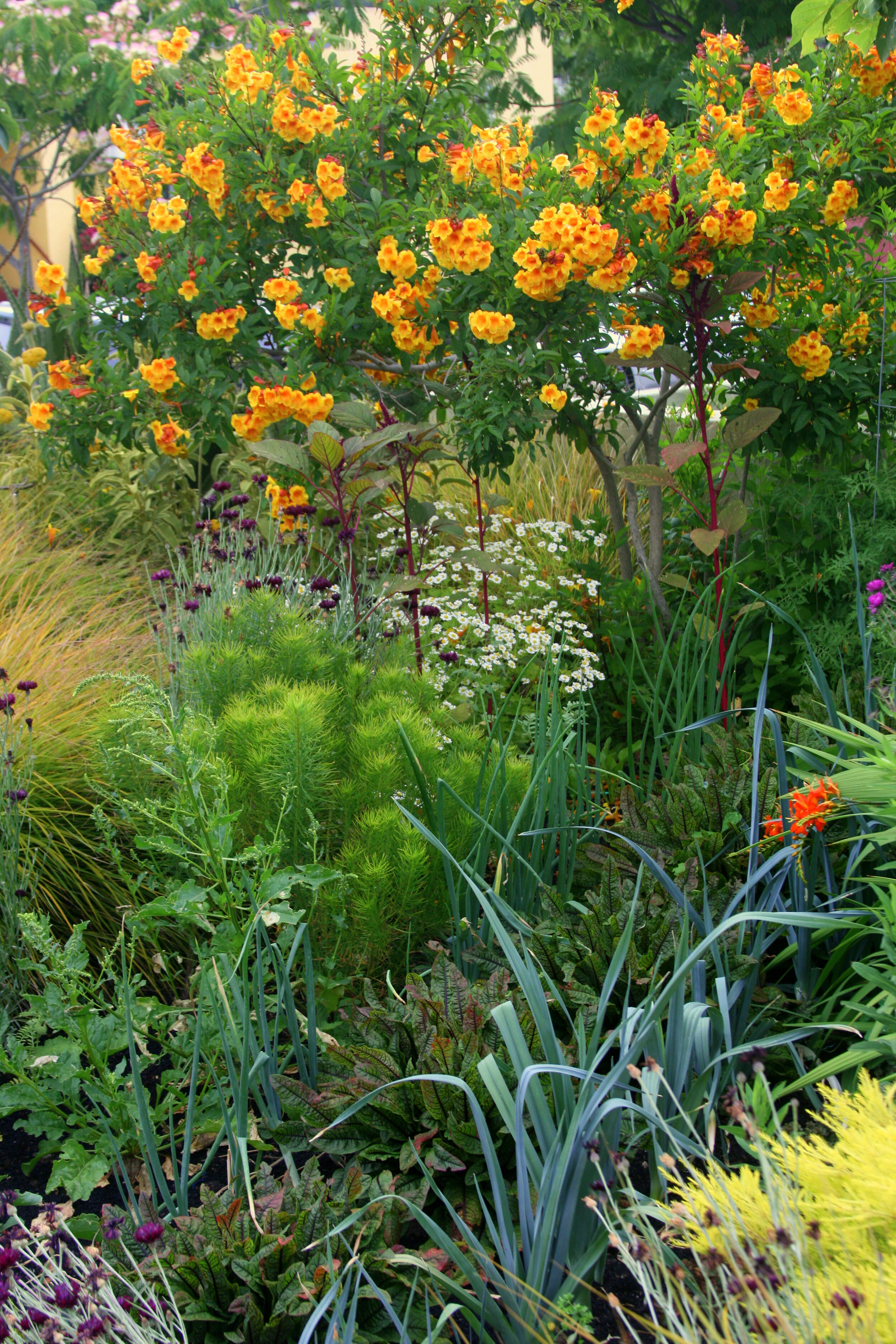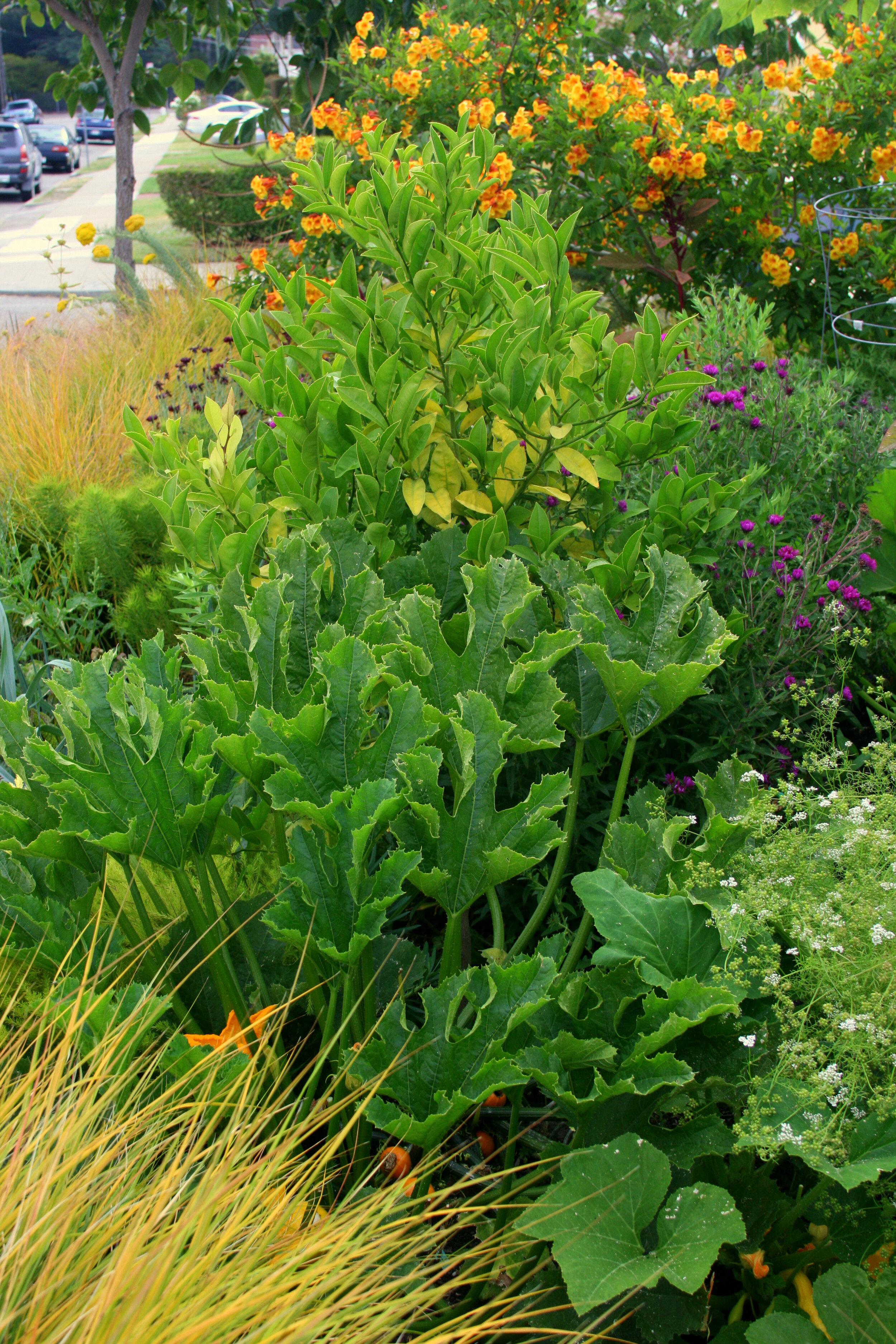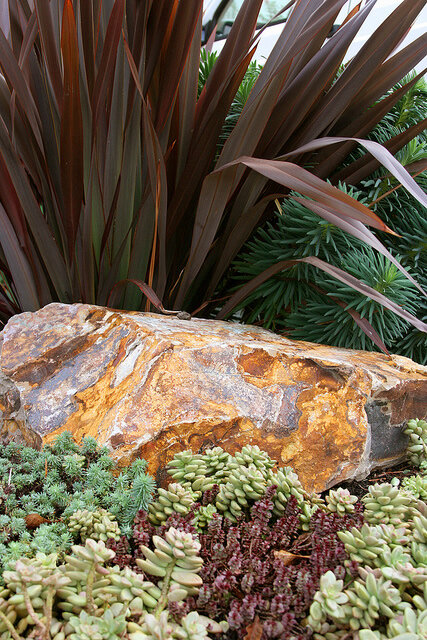Photo courtesy of Andrea Doonan.
HABIT-ABLE GARDENS AROUND THE STATE
by Leesa Martling leesa martling landscapes, Los Angeles, CA
Playground For Birds and Bees in Laurel Canyon
A small terraced back garden in Laurel Canyon needed some sprucing up. The little house looks out on the hillside with an opportunity for a lively view of the goings-on outdoors. A couple of house cats were involved—along with their owner—who like to watch the birds and bees flutter about from the numerous cottage windows.
So a playground for the birds and the bees became the plan, mixed with eye-catching color and a touch of whimsy.
Bird feeders and baths were placed in the window sight-lines, along with an array of garden art and sculpture. An exuberant no-holds collection of flowering shrubs and plants were added to compliment the brightly colored tin figures and attract anything that may fly or ramble by.
We chose not one, but two Brugmansia “Charles Grimaldi” shrubs that provide a nice perch for the flock of finches that visit everyday. Also an Alyogyne huegelii “Santa Cruz” that attracts pollinators, and a few Salvia and Lavandula for the hummingbirds and whomever else needs a sip or a dusting.
Sedge and Flax were added for contrast and cover for the nocturnal critters that browse the garden at night. Clumps of cascading Erigeron and Rosemary were included as well as bright spots of Statice, Osteosperomum, and Pelargonium to create a delightful tangle of garden habitat for all to enjoy.
I’m happy to report the cats, birds, bees, and one lovely human all thrive together in this little wonderland on Lookout Mountain, where life doesn’t seem so hard, even with zero cats allowed in the yard. Now everything is easy with a view, too!
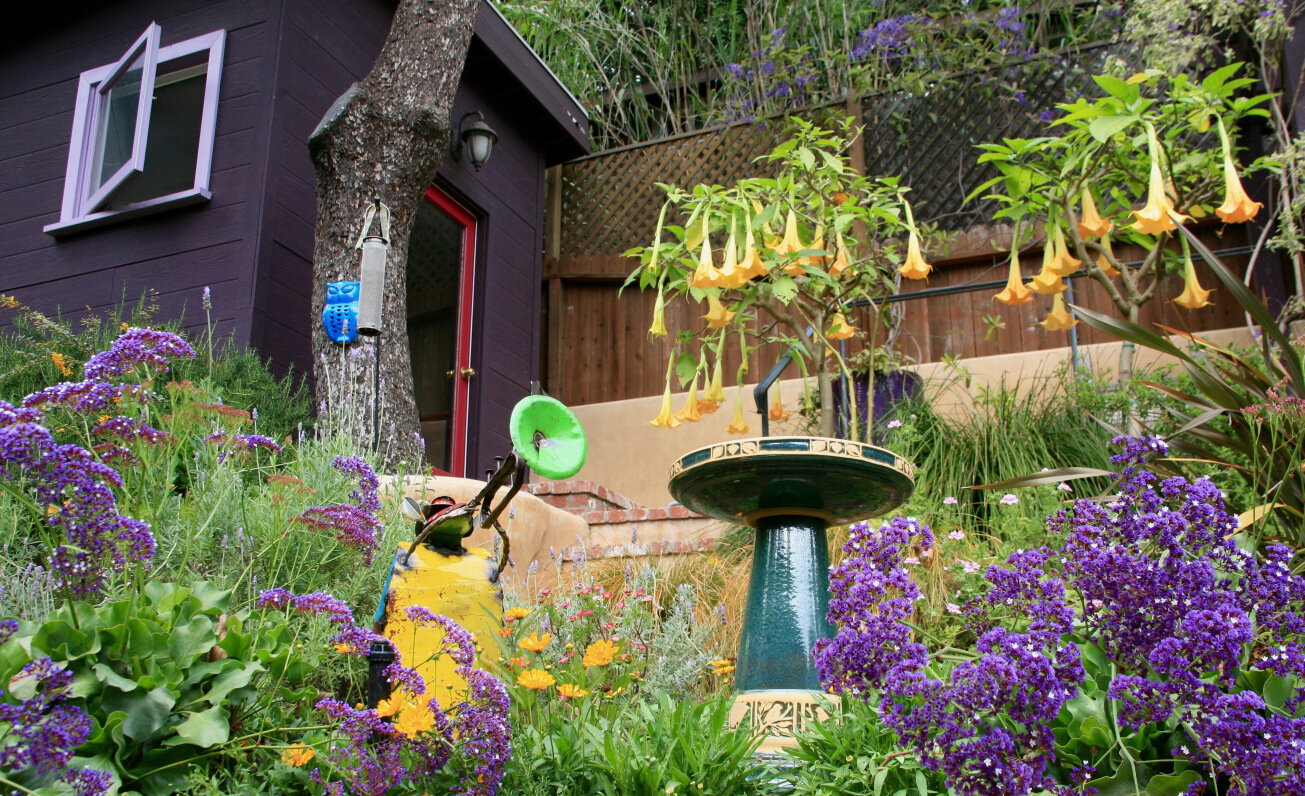
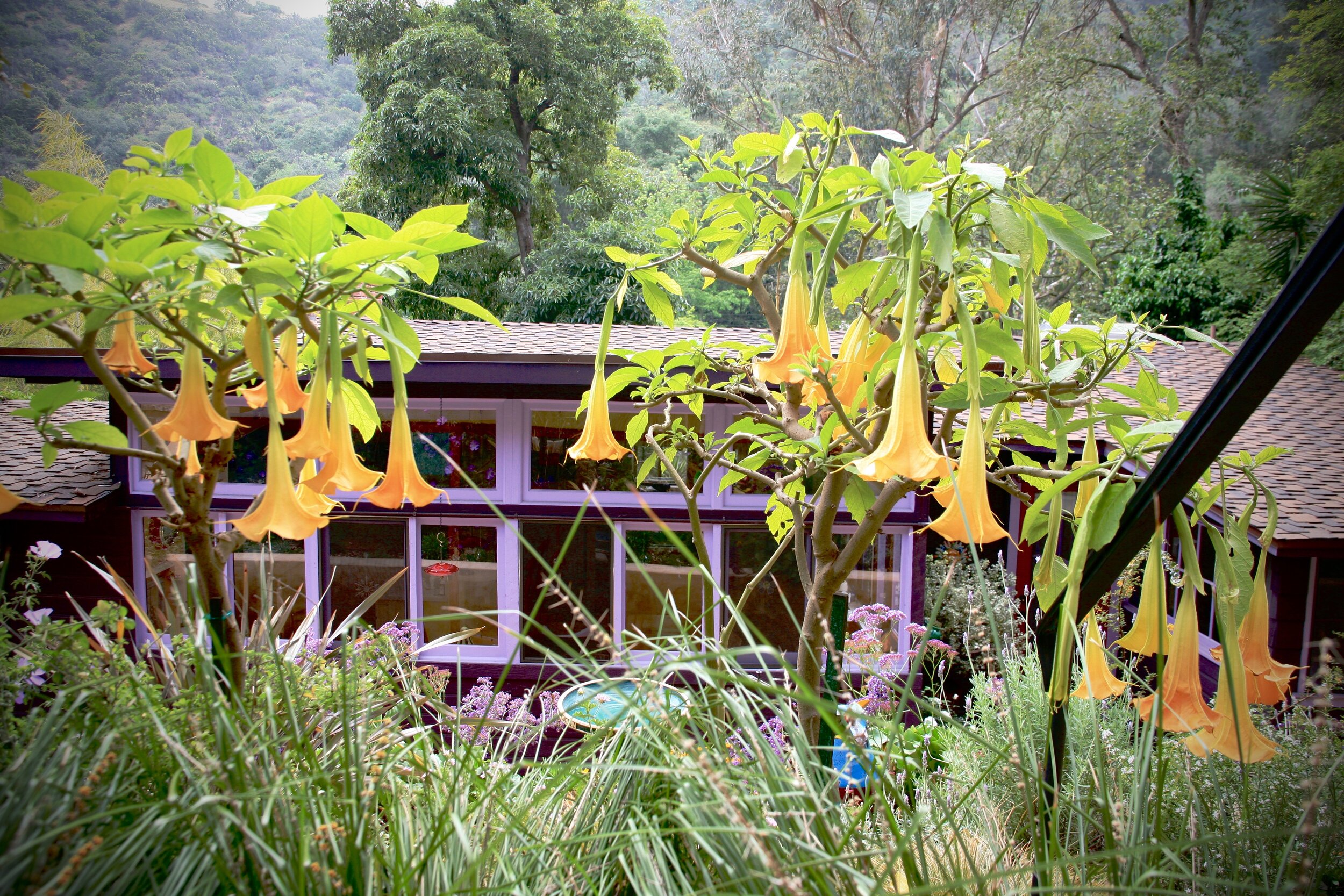
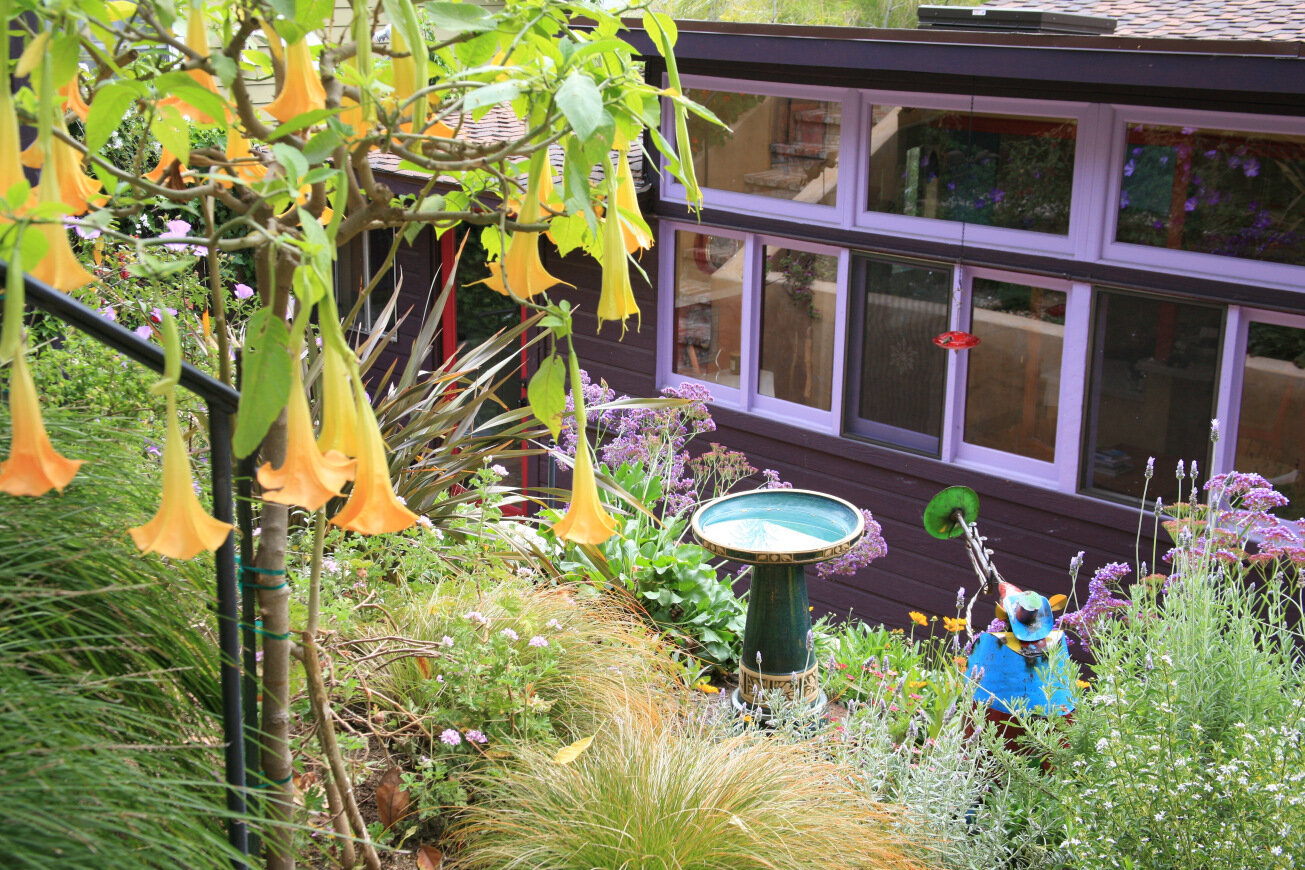
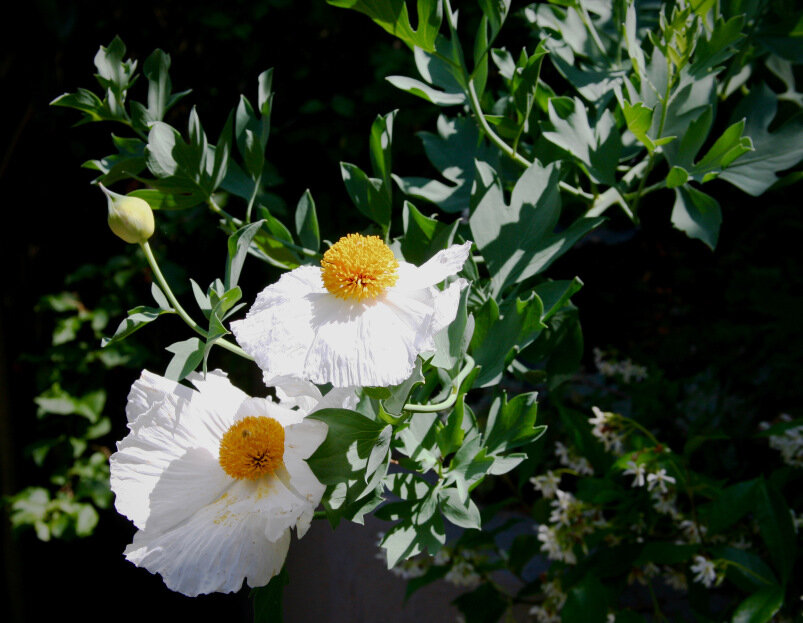
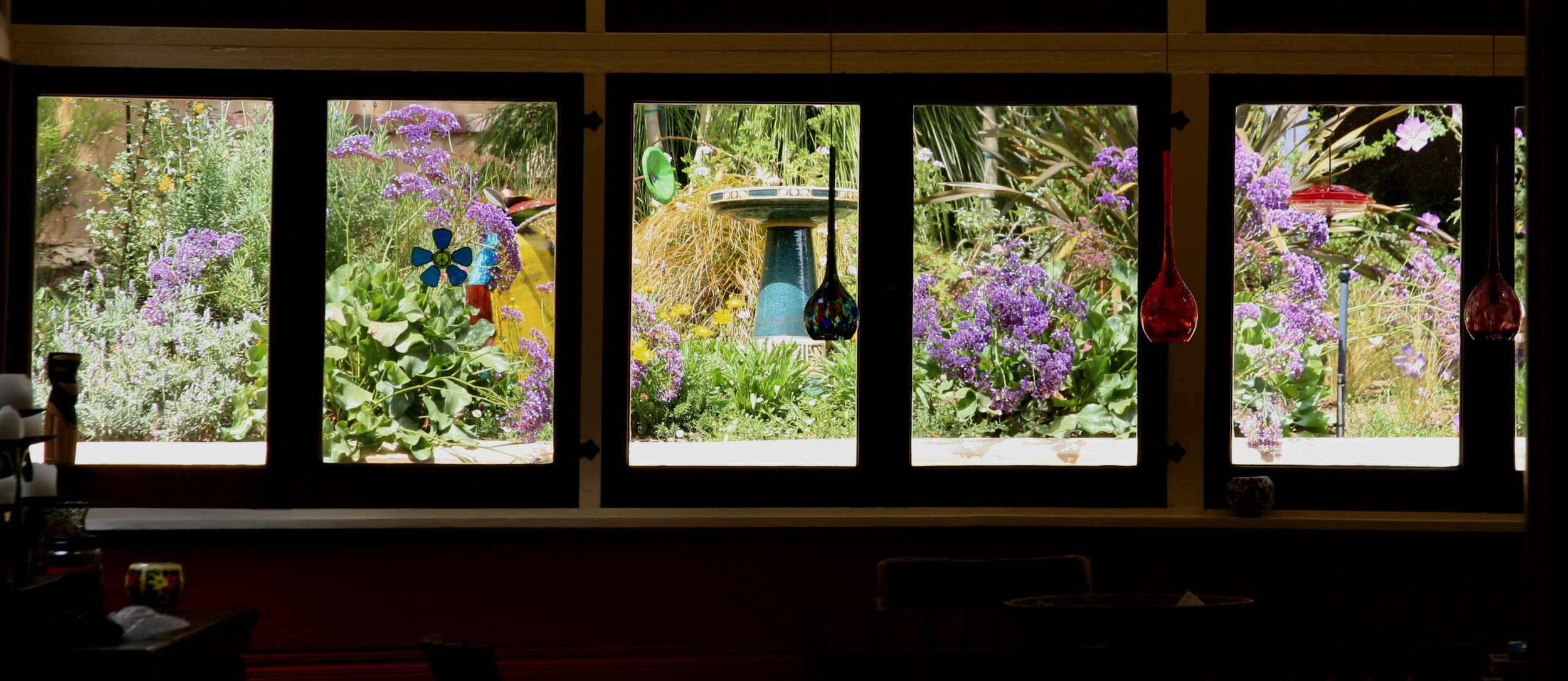
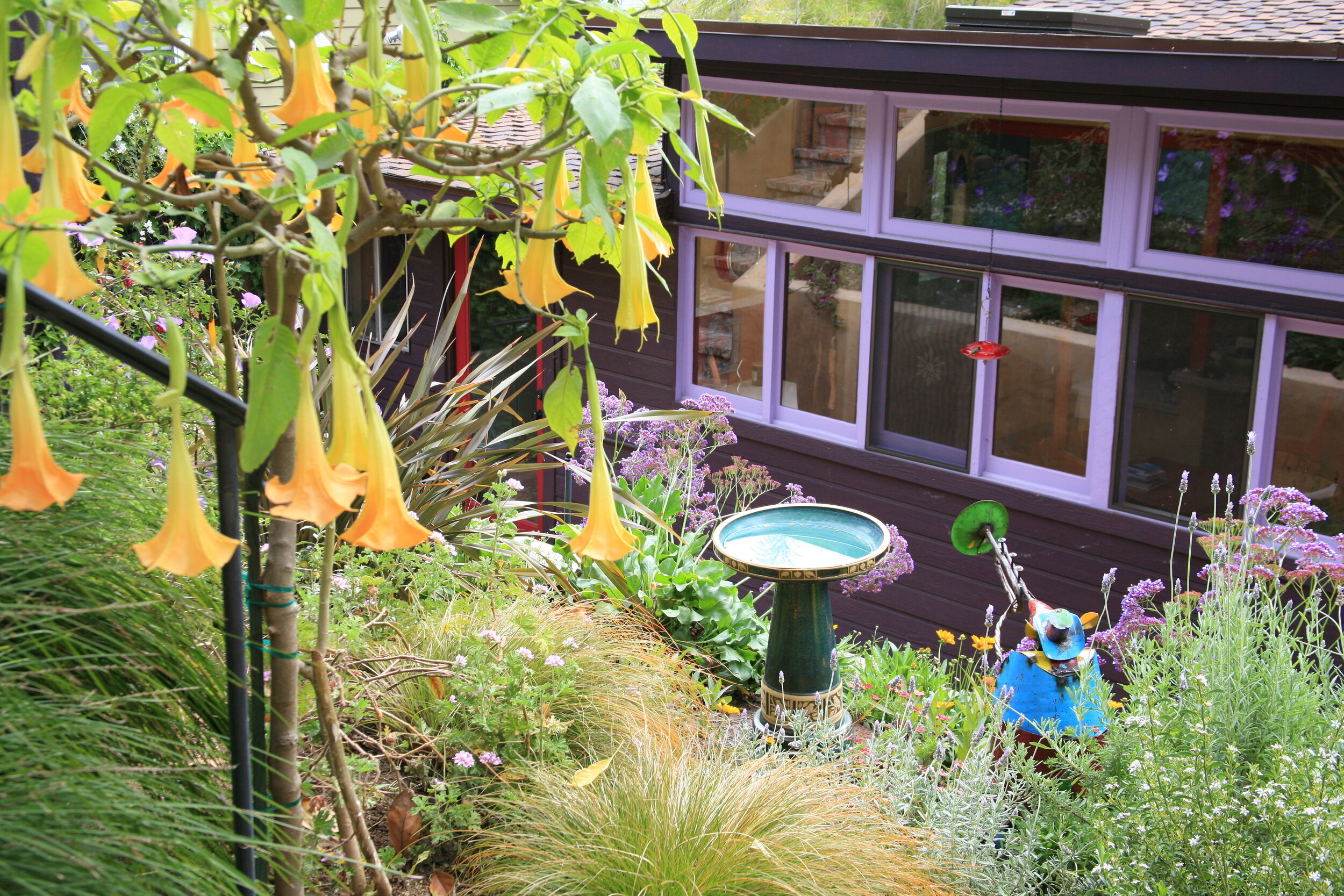
Photos courtesy of Leesa Martling.
by Phoebe Barkan & Winnie Creason
Plant Stars
Berkeley, CA
Pollinator Paradise in Fremont
This Fremont front garden has been transformed into a blooming paradise for pollinators. Out with the lawn, and in with drought-tolerant grasses, flowering perennials, annuals. succulents and shrubs. A shallow stone basin provides a hydration station for butterflies and bees. Staggered bloom times extend the nectar and pollen season: Ceanothus flowers in the late winter, Eschscholzia californica and Achillea millefolium 'Sonoma Coast" in spring, Verbena bonariensis and various Salvias in the summer, and Epilobium 'Everett's Choice’ in fall. Waiting to cut back perennials and grasses until early spring—such as Muhlenbergia rigens—creates critical winter habitat for many beneficial insects, especially ladybugs.

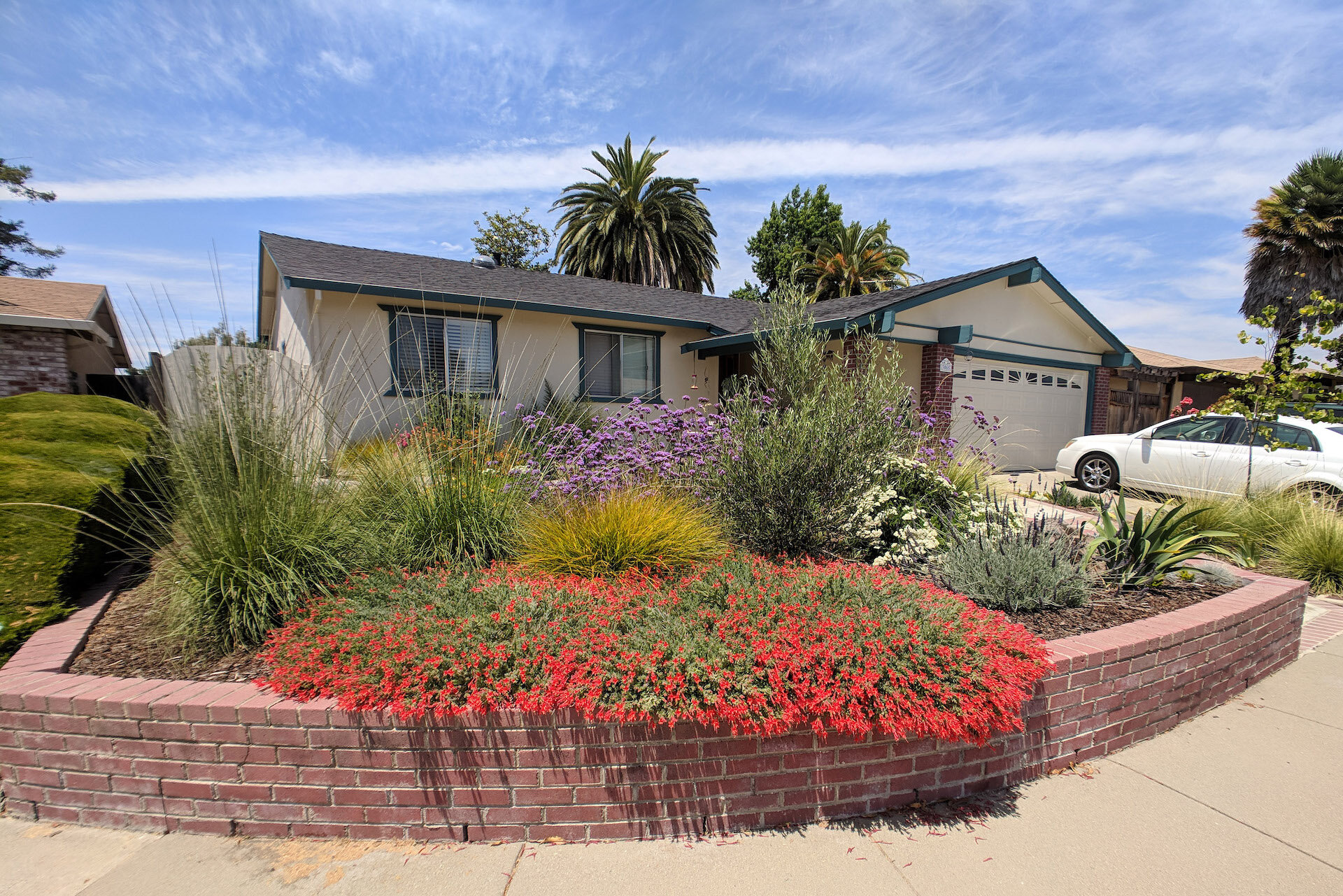
Photos courtesy of Plant Stars.
by Tricia Christopher
T. Christopher, Landscape Architect
Oakland, CA
A Cottage Garden Habitat in Oakland
This small cottage garden in Oakland provides ongoing delight for wildlife and humans alike. Barren and water-consuming lawns were removed to make way for gravel areas surrounded by a variety of plants that provide food, nectar, and habitat. Shallow water bowls and fountains were added for insects and birds to drink and bathe. All of the buzzing and flitting activity in the garden now provides endless entertainment for people, too!
Sitting areas were created with permeable gravel to allow rainwater to percolate and restore the groundwater. Surrounding plants, such as Salvia, Abutilon, lavender, California poppies, and Phygelius provide plenty of nectar.
Hummingbirds love Flowering Maples. Abutilon ‘Halo’ is one of my favorites.
Many edible herbs have flowers that are loved by insects, including marjoram (shown here), thyme, oregano, sage, lavender, and rosemary. These low-water perennials are easy to grow, beautiful, and inspire creative cooking.
A groundcover tapestry of Wooly Thyme, Goldenrod, and Rubus pentalobus provides food and nectar.
Placing pebbles in the bottom of water bowls makes the water level shallow enough for birds to feel comfortable.
A submersible pump under a fountain circulates water and prevents mosquitoes. Surrounding shrubs provide shelter and perches for birds as they take turns bathing.
Both humans and birds love blueberries, and there’s plenty to share! Even honeybees enjoy the ripe fruit when nectar is scarce. Hybrid varieties that need less winter chill can be grown in the Bay Area. Routine applications of coffee grounds around the plants and an annual application of fir bark compost keeps the soil acidic. Raspberries are also easy to grow, and make a great combo with blueberries!
Photos courtesy of Tricia Christopher.
Bird feeders add to the food supply. Safflower seeds in an elevated dish attract birds, not squirrels or rats (and safety from cats). Cracked sunflower seeds (fine chips) in hanging feeders attract all variety of finches. Feeders spring shut with anything heavier than a bird prevent unwanted guests.
by Kelly Kilpatrick Floradora Garden Design
Oakland
An Experimental Garden in Oakland
An ongoing and evolving garden, this project is a lab for trialing new plants and experimenting with new color palettes and textures. Meant to add a quirky fun element to the neighborhood and to engage local children into thinking about the joys of gardening. An emphasis is placed on providing food sources for beneficial insects and birds. After removing the existing lawn and junipers, the garden was planted with beautiful but drought tolerant plants. Once surrounded by a sea of neighboring lawns this garden is now being joined by other new, fun, converted gardens.
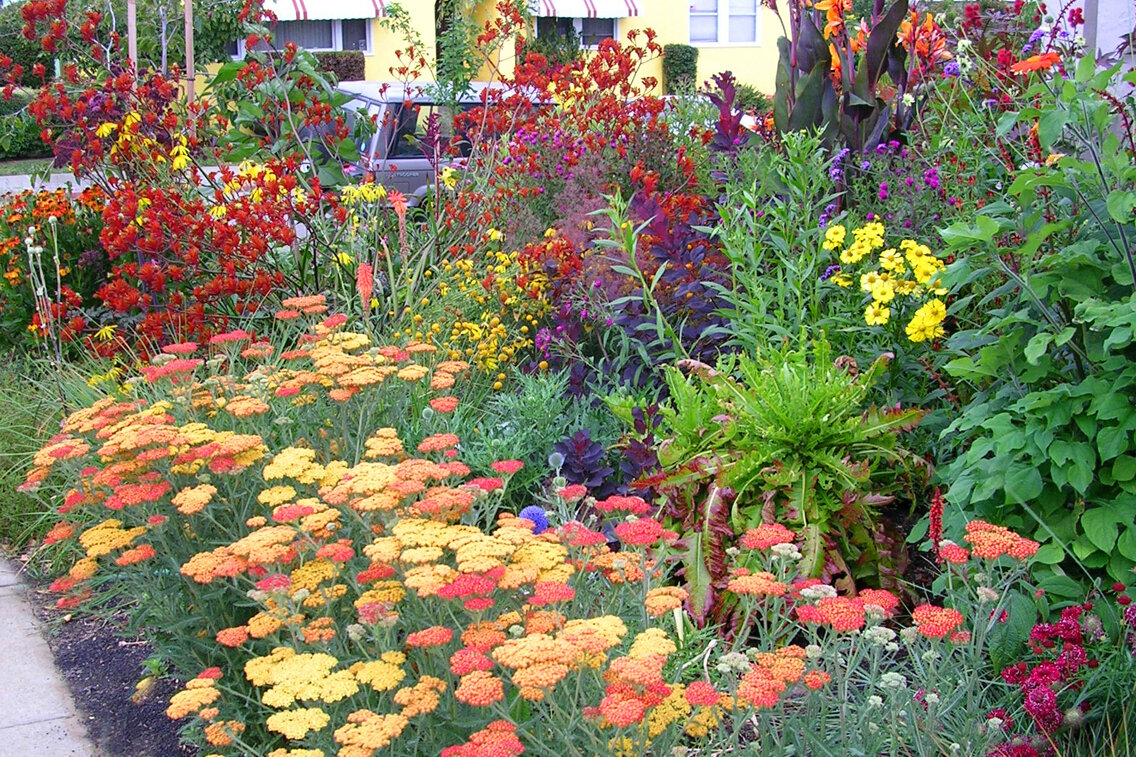
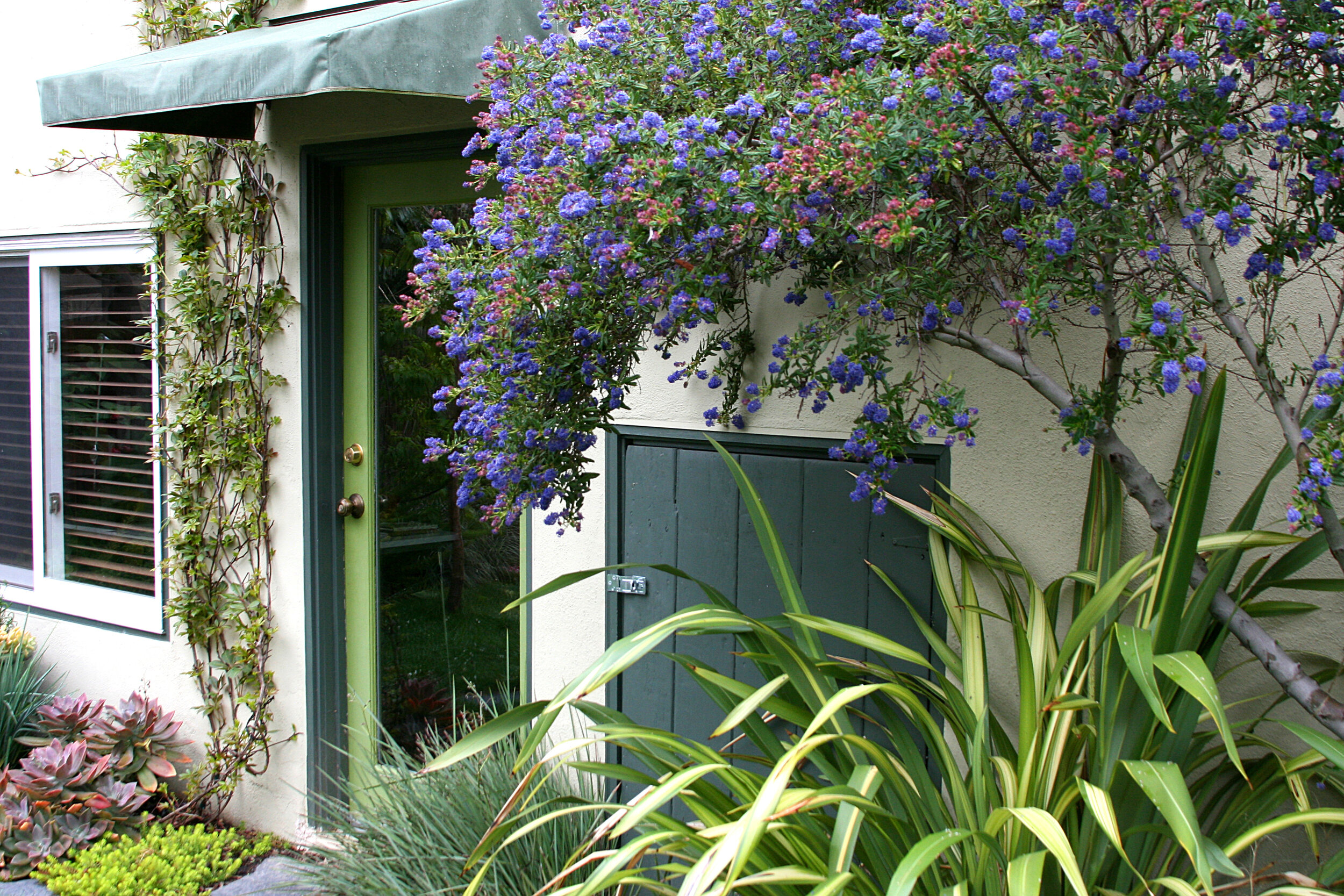
Photos courtesy of Kelly Kilpatrick.
Wildlife Retreat Garden in Oakland
A dramatic garden created from a simple, flat, barren front yard by sculpting and mounding the terrain, incorporating boulders, and using bold textures and colors in the plantings. The resulting garden hugs the house and creates a welcoming retreat from a long day at work. The plantings utilize bee, butterfly, and bird friendly plants so that there is plenty of activity for the wildlife-loving owner to enjoy watching while relaxing.
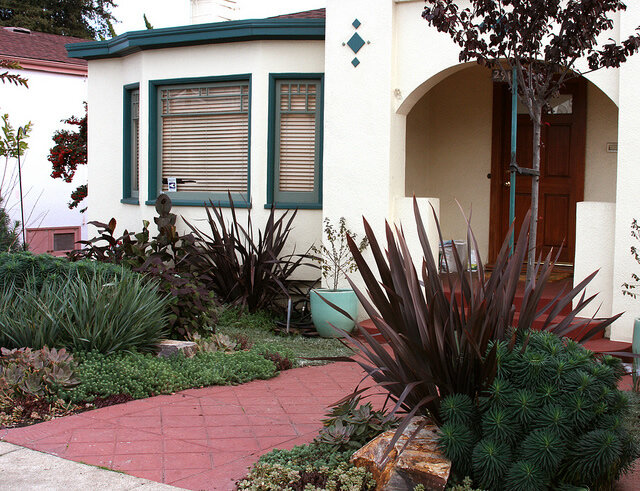
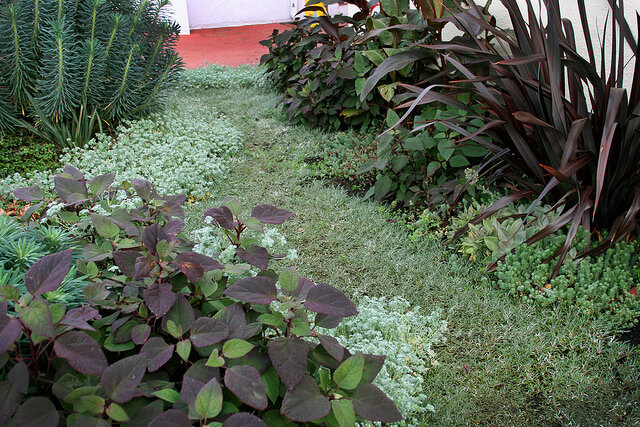
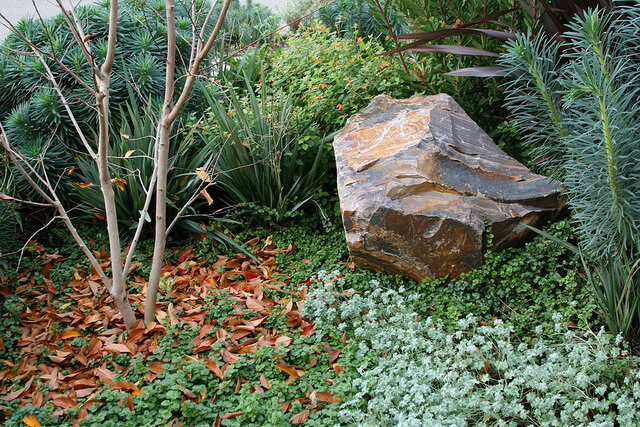
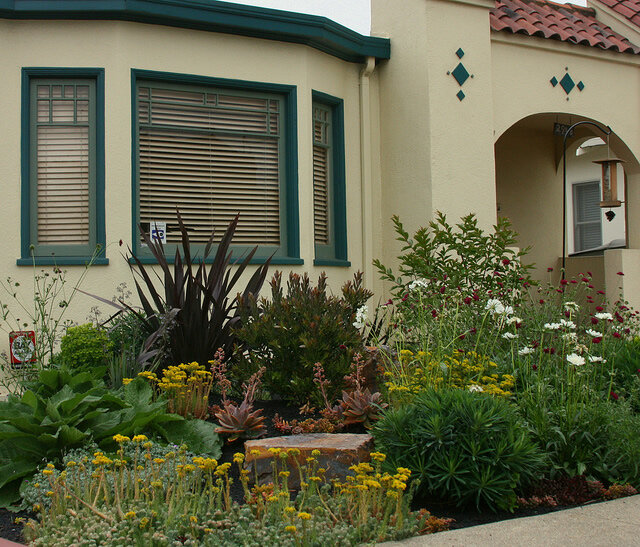
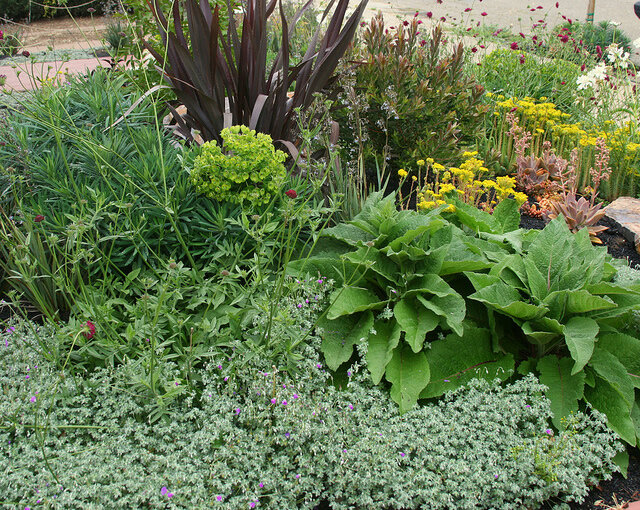
Photos courtesy of Kelly Kilpatrick.
by Andrea Doonan Andrea Doonan horticulture + design
San Diego, CA
Wildlife Garden in San Diego
This North Park San Diego front yard has been transformed from front lawn to a habitat garden. There are native plants including sages, buckwheats, penstemon, sedges, and verbena lilacina that support many native pollinators, birds, and insects along with non native platinum beauty lomandra and other spreading waterwise plants as well as large boulders, that give places for critters to live. A dry creek bed slows the rainwater, allowing it to percolate on site. There is a bird bath and bird feeder that are placed high off the ground to protect from neighborhood cats. In these urban and suburban San Diego neighborhoods, we are essentially concrete islands surrounded by pockets of canyons with fingers extending through the neighborhoods; I like to think of wildlife gardens as little stepping stones for the native birds, reptiles, and invertebrates to re-wild our earth a bit more. Having a true habitat garden also means waiting longer to deadhead certain plants that can be enjoyed by birds, etc. For people that like the less wild look, I say you can keep it tidier in the front and let the sages go to seed in the backyard instead.


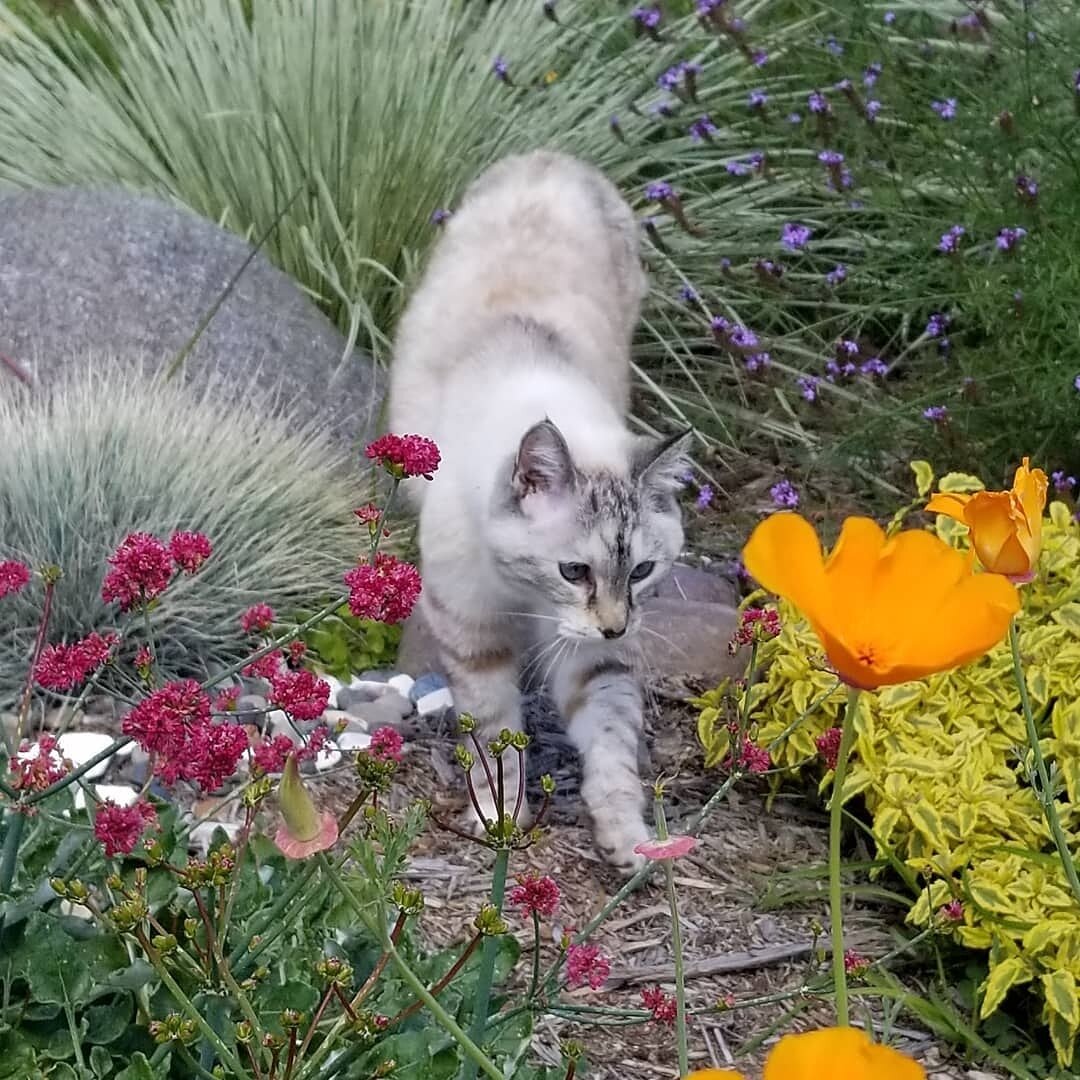
Photos courtesy of Andrea Doonan.
by Gary Kernick Change of Seasons
Sacramento, CA
Midtown Meadow in Sacramento
This small back yard was basically lawn in a box before our renovation. The new owners wanted their garden to come alive and welcome birds, butterflies, and bees. A fountain crafted from an old plow disc provides a drink for visiting insects, and frequent baths for birds. Achillea Moonshine, Buddleia Pugster Purple, Kniphofia Echo Mango, Salvia Caradonna, and a range of meadow grasses provide an inviting habitat. Removing the boring back lawn made room for an eco-friendly meadow with multi-level entertainment areas. Yarrow, butterfly bush, and fountain grass enliven this organic farmhouse style garden. Hummingbirds welcome.
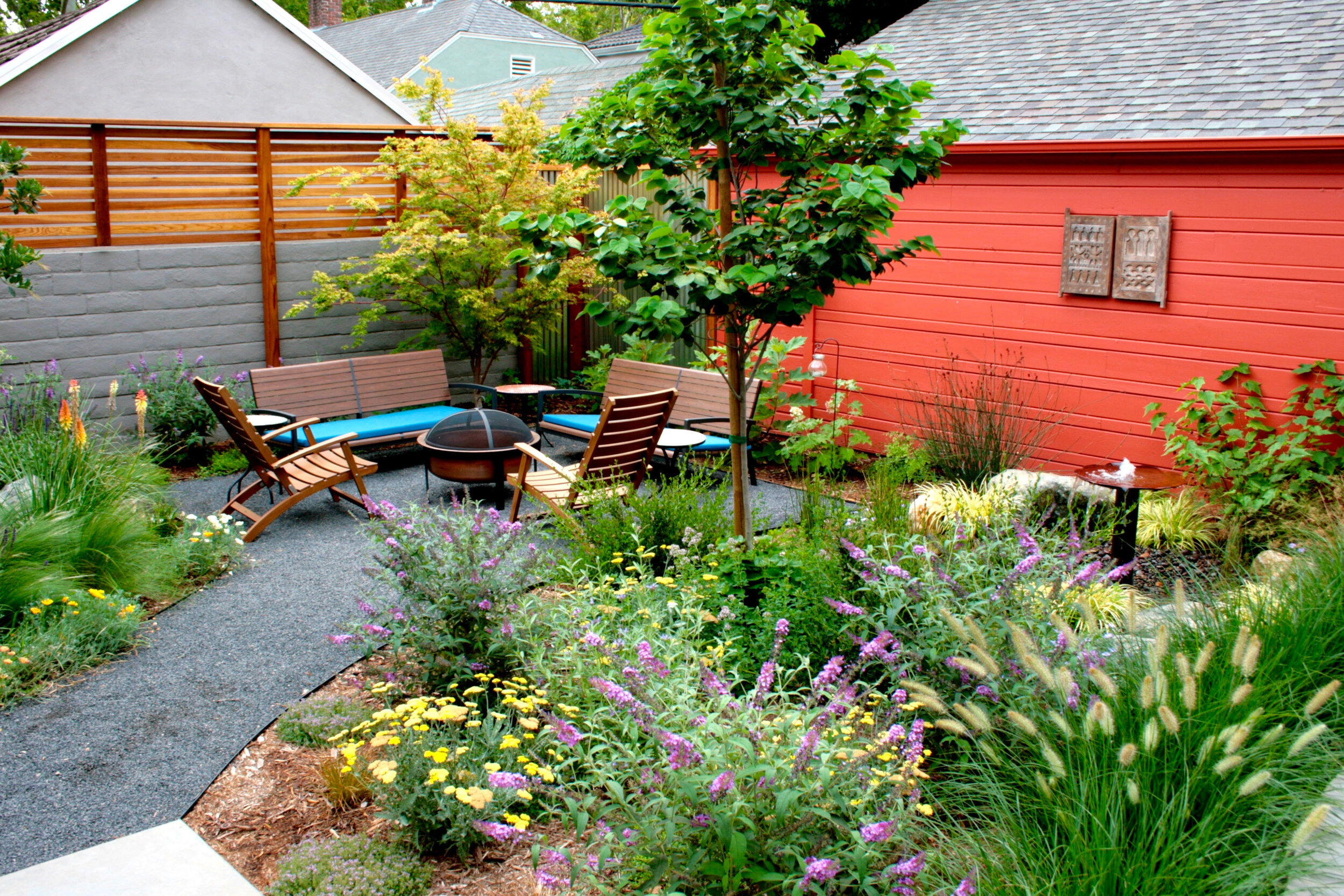
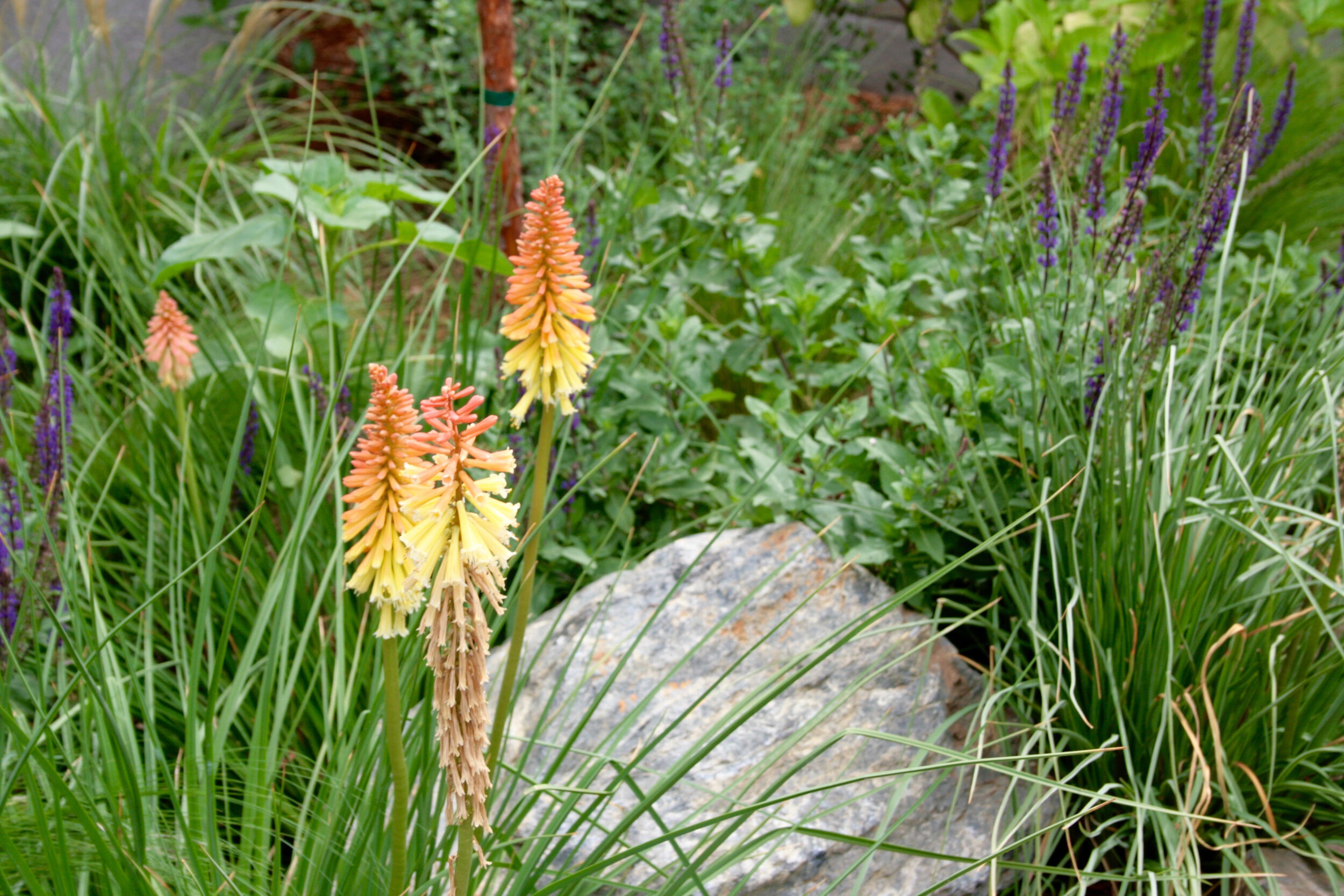
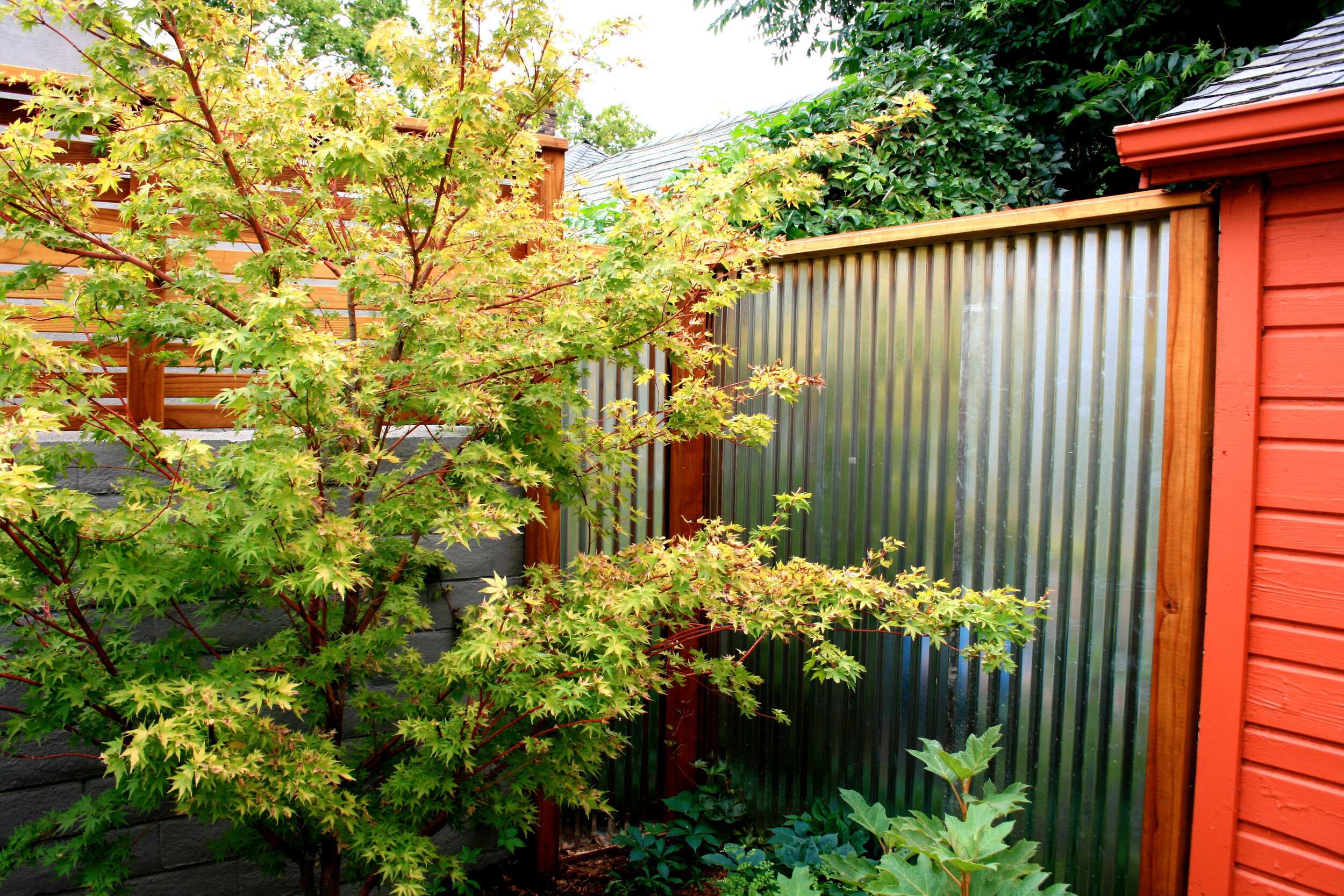
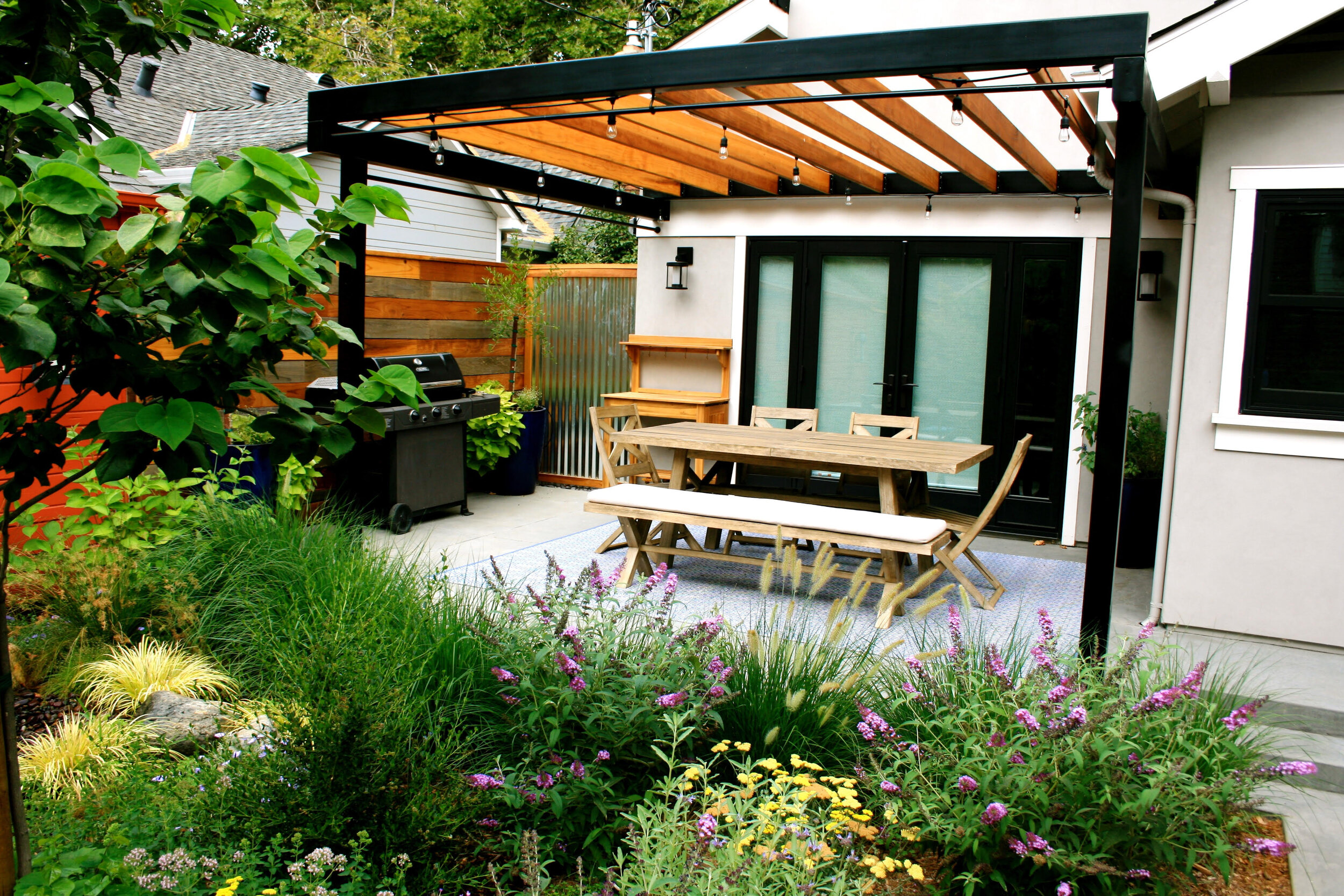
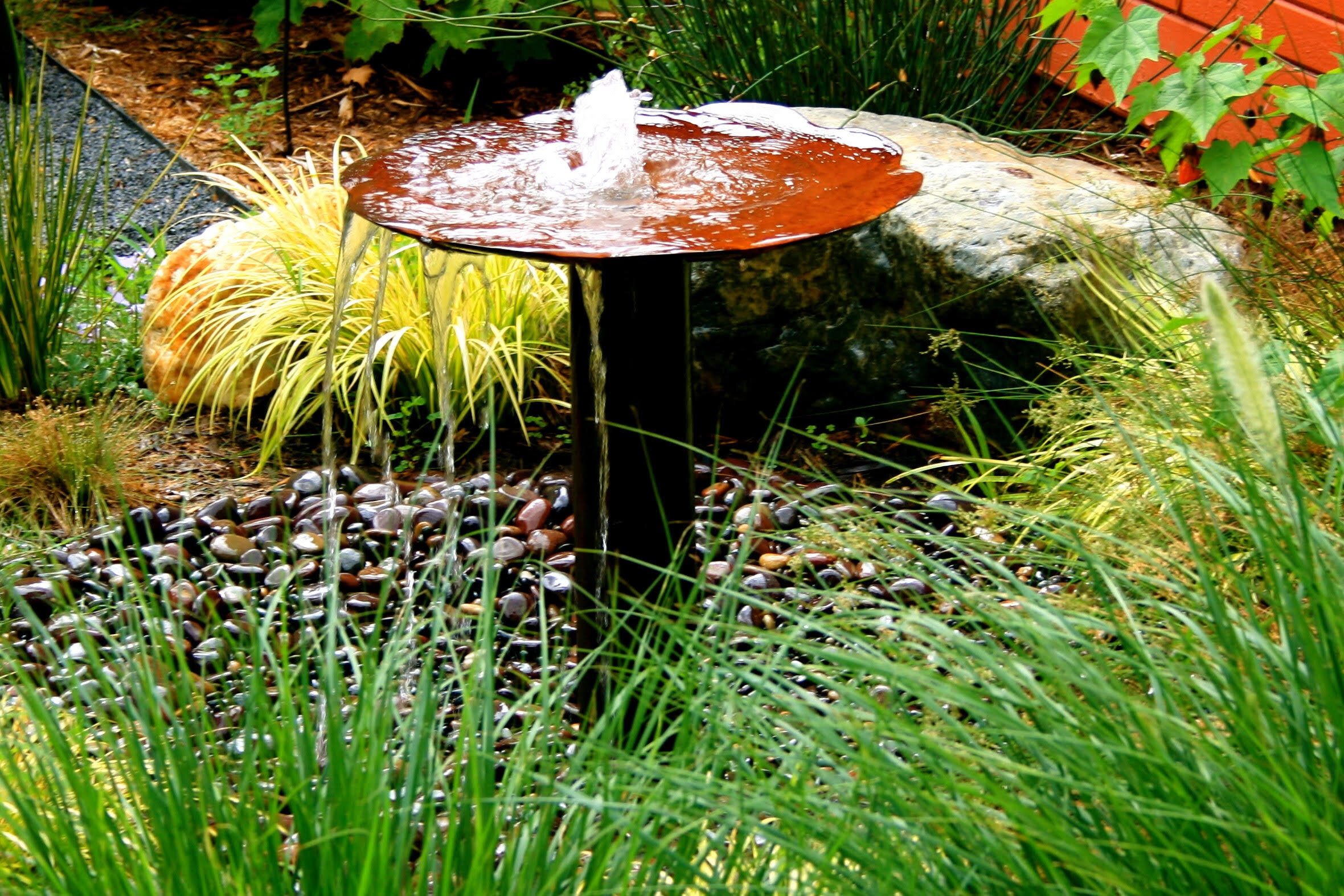
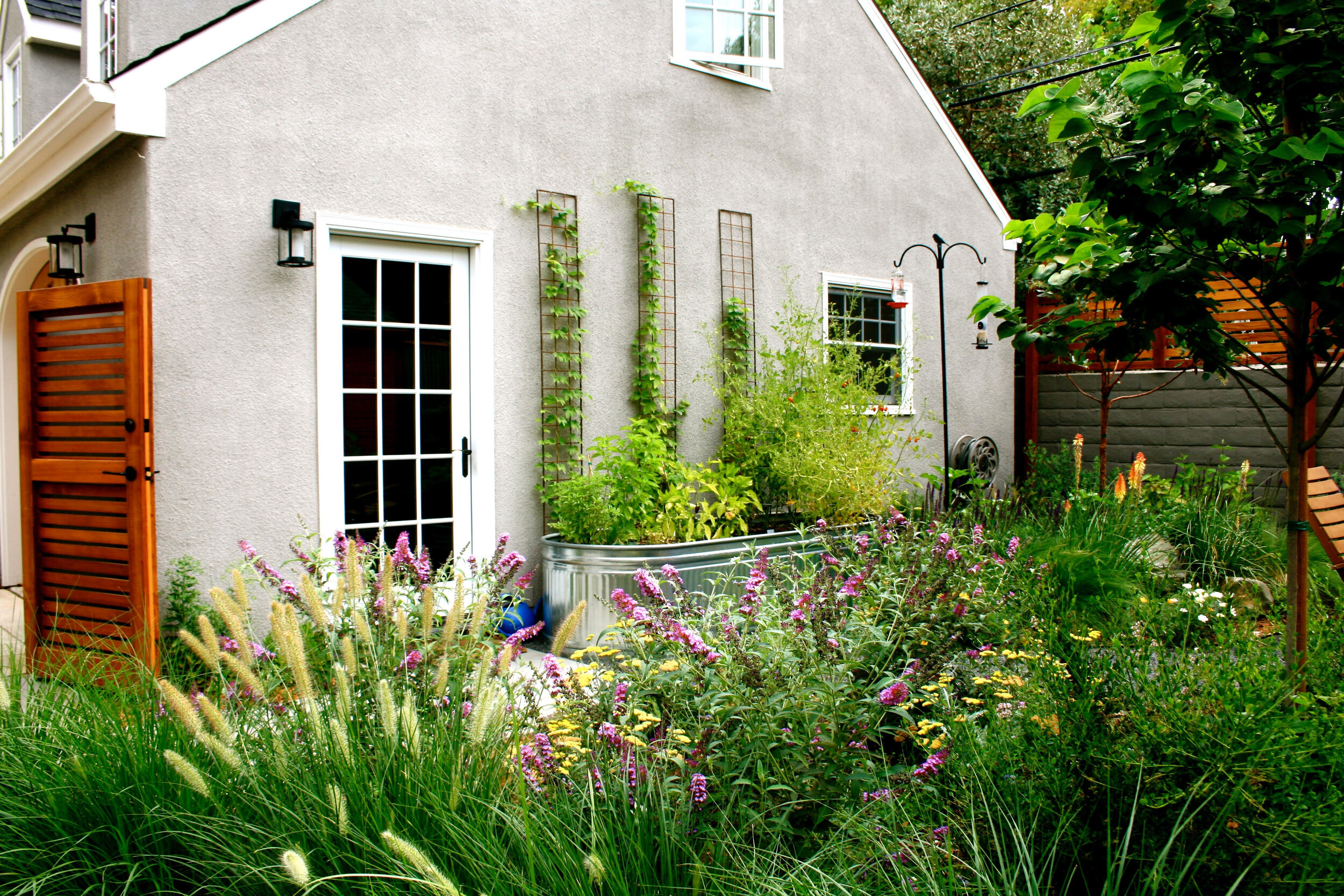
Getting To Know You:
Meet a Few of our Newest Members
We reached out to our new members with a few questions
so that we can all get to know a bit more about them.
Where did you grow up and what is your earliest experience in nature/the landscape there?
What is your current favorite landscape plant?
Are you reading anything inspiring right now?
How did you find out about APLD, and what led you to join?
Qualified Professional Members
A landscape designer who engages in the practice of landscape design for monetary compensation and contains more than 3 years of professional landscape design experience. Documentation of education and experience is required.
Marie 'Kit' Veerkamp
EcoLogic Designs
Cool, CA
Q: Where did you grow up and what is your earliest experience in nature/the landscape there?
A: I grew up in Southern California and summered at my uncle’s ranch in Reno, Nevada as a child. I remembers always being the kid who was drawn out into the suburban backyard, I loved to weed and mow. My early fascination with nature persists as I dive deep into the fiber arts world of natural dyes and botanical printing.
Q: What is your current favorite landscape plant?
A: As per usual, it was hard to choose just one favorite plant, but the current winners are Lepechinia hastata and Spaeralcea ambigua, both of which cheerfully fill seasonal bloom gaps for pollinators and weather the unpredictable Sierra foothills climate where I live and work.
Q: Are you reading anything inspiring right now?
A: Right now I am listening to the novel Overstory, recommended by industry friend Steve Zien. “If trees could speak, what would they tell us?”
Q: How did you find out about APLD, and what led you to join?
A: I had been hearing about APLD from a couple active designers in the Sacramento area, and finally joined when I attended the G3 Watershed Training hosted by APLD Sacramento last November. I am impressed with the quality of events and classes, as well as the people who are working to make it all happen for the organization. The dues are expensive, but worth it for the value received.
Katerina Mattis
Mattis Design Studio
San Diego, CA
Q: Where did you grow up and what is your earliest experience in nature/the landscape there?
A: I was born and raised in Switzerland by Greek immigrant parents. I was lucky to experience and live in two countries that couldn’t have been more different in their environment and culture. In Switzerland I lived in a small town within walking distance to forests, farmland and community gardens. Switzerland is known for their community gardens that are available to all citizens for a small rental fee. About 70 percent of Swiss residents live in apartments and the plots give everyone the opportunity to grow their own food. Most plot renters, like my father, take it very seriously and make a point of feeding the family with the produce they grow. I have fond memories of walking around our garden and picking produce such as rhubarb, berries, potatoes, peas, tomatoes, cucumbers, green beans, garlic, onions, lettuce, and zucchini. All the gardens come with a small 20 square foot shed that looks like a miniature house with tile roof, rain gutters & rain barrel. Most people keep a small outdoor masonry fireplace for BBQing on the plot and many meet on the weekends for lunch or dinner. It’s a bit like the farm to table gatherings that have become so popular in California. There was nothing better than when my dad put Cervelat, Bratwurst and drumsticks on the small fireplace grill which was then served with delicious vegetables from the garden. Eating while hearing cow bells in the distance and looking over sunflower and cornfields was pure bliss. It was only during the summer months that we filled up water cans to water the vegetable beds. Hoses in the community gardens are prohibited. The Swiss take water conservation very seriously even though they get about 75 inches of rain per year.
During the summers I lived on my mother’s birth island of Tinos in the Greek Aegean Sea. The island gets hardly any rain, especially during the summer months and the landscape looks accordingly. Low growing shrubbery, no greens, just light yellows as far as your eye can see. I love the splash of color the bougainvillea provides in the very monotonous landscape. When I moved to San Diego in my twenties, I realized that the Aegean islands and coastal San Diego have very similar climates and that San Diego would look very much like Tinos if we didn’t use hoses and irrigation systems. Tinos runs out of their water supplies during the summer months and the local government shuts off all water during certain hours to manage the water shortage. I appreciate the natural beauty of the island and what it provides to its inhabitants. I have fond memories of getting up early with my dad to hike up to the higher elevations to pick oregano grows wild on the island. Once back at home we would bundle it and let it dry. The fragrance would stay with me for days. The island is also known for its artichokes that grow in abundance during the spring and this is celebrated with an annual artichoke festival. Villagers (mostly women) prepare about 10,000 artichokes in every possible way. I also remember that the pomegranate fruit grown on the Island seemed very exotic to me. My father would dry the fruit and hang it on the rear-view mirror in his car for good luck. It would last all year and when we were back in Switzerland for the Winter it was a nice reminder of our other home in Tinos.
The two landscapes I grew up in are a big part of me and how I approach my design jobs. It’s about finding the balance between respecting the natural landscape of San Diego and creating a landscape that will feed the client’s soul.
Q: What is your current favorite landscape plant?
A: I am currently obsessed with proteas. They are native to South Africa and I absolutely love their unique and stunning flowers. They are drought tolerant and hardy and create instant drama in the landscape. The exotic flowers also look great in bouquets. It makes perfect sense that they were named after the Greek god Proteus, son of Poseidon, who was capable of transforming into many different shapes. The flowers truly seem like they are from a different time.
Q: Are you reading anything inspiring right now?
A: I am currently reading The Art of Outdoor Living by Scott Shrader. His designs are a constant inspiration. The landscapes he creates are simple but stunning. He works with different greens rather than bright colors and flowers. Every element in his work is placed with intention thus creating sophisticated outdoor rooms. His designs have a European feel and he uses a lot of reclaimed olive trees, gravel and stone hardscapes.
Q: How did you find out about APLD, and what led you to join?
A: I first heard about APLD in a landscape design class. I joined years ago but it didn’t really get involved until this past December when Abby from Village Nurseries got me in touch with Anne-Emilie. Anne-Emilie invited me to the December holiday party, and I got to meet other APLD members. I am very excited to be part of this group.
Professional Members
A landscape designer who engages in the practice of landscape design for monetary compensation and contains more than 3 years of professional landscape design experience. Documentation of education and experience is required.
Laura Osteen
Secret Garden Landscapes
Moraga, CA
Q: Where did you grow up and what is your earliest experience in nature/the landscape there?
A: I grew up in Moraga, Ca in the SF Bay Area. My earliest memory of really connecting with nature was when I was 5 years old and I went on a backpacking trip with my Dad. We went to a place called "Frog Lake" (not too far away from my house) and boy did we find out why it was called frog lake that night! I hardly slept that night (so much croaking!) but the changing of the environment around me from our hike during the day to the night life really fascinated me.
Q: What is your current favorite landscape plant?
A: Arctostaphylos 'Emerald Carpet' - It is blooming now(March) and I love all the beneficial insects it attracts. I can't help but stop what I am doing when I past by these plants and just watch all the activity buzzing around it.
Q: Are you reading anything inspiring right now?
A: I just finished reading "Protecting Pollinators: How to Save the Creatures that Feed our World" by Jodi Helmer. I highly recommend it! It is well written and very informative.
Q: How did you find out about APLD, and what led you to join?
A: I found APLD in a web search looking for others to connect with. I look forward to learning and sharing with others about the wonderful field that we all get to work in.
Don Schneider
Designs by Don
Santa Cruz, CA
Q: Where did you grow up and what is your earliest experience in nature/the landscape there?
A: I was born and bred in the Central Valley here in California, in a small farm community of Dinuba, just 30 miles southeast of Fresno. My earliest experiences of nature (aside from the multitude of farms in the area) was the Sierras jut minutes east of us. Within a few hours’ drive were Three Rivers, Sequoia Park, the redwoods, Hume Lake and as sundry reservoirs where we’d vacation. (And if I’d walk to the end of our single block street and turn east, you could see the vista of the foothills ascending to the snow-capped mountains beyond.)
Q: What is your current favorite landscape plant?
A: I’ve become quite fond of the Loropetalum family (especially the ‘Razzleberri' and ‘Purple Pixie” varieties). They’re versatile and can add great variety and accent with not only their flowers but leaf colors as well.
Q: Are you reading anything inspiring right now?
A: Been doing a lot of reading about our nation’s founding and the constitution of late (surprise) and have found inspiration in the creative steadfastness of those serving the needs of others.
Q: How did you find out about APLD, and what led you to join?
A: Actually, I’ve been doing design as part of my landscape business since beginning in the 1980’s. But now that it’s the focus rather than a part of installation (which I no longer do), I was searching online for professional organizations to help better my abilities and bring them up to more of an “industry standard” of quality. APLD seemed to fit those goals well and has already made a difference with the few seminars I’ve been able to attend.
Deborah Austin
Austin Design - Landscape & Garden
San Diego, CA
Q: Where did you grow up and what is your earliest experience in nature/the landscape there?
A: I was born and raised in San Diego, CA. My earliest experience in nature/the landscape was going to the beach and camping in the mountains. Picking roses for my mom from my neighbor’s rose garden. Eating sour grass in the springtime and the pretty pansies that grew in a white window box that I would pass on my walk to school. Pansies are still my favorite flower. My earliest memories also include maneuvering around my moms endless seeds in pots and a big family vegetable garden we created one year.
Q: What is your current favorite landscape plant?
A: Hard to pick 1 plant but I love Tecoma X ‘Orange Jubilee’. It’s indestructible, needs very little water but looks lush and colorful.
Q: Are you reading anything inspiring right now?
A: I find it easier to listen to audio books. I’ve got two books going currently, The Audacity of Hope by Barack Obama and Kiss the Ground by Josh Tickell.
Q: How did you find out about APLD, and what led you to join?
A: I found out about APLD from school, I think. I circled it for years and attended events that were open to me before I finally made the investment. I could see how close and supportive my local chapter members were with each other and I wanted to be a part of that. I wished I had done it sooner.
Phoebe Barkan
Plant Stars
Berkeley, CA
Q: Where did you grow up and what is your earliest experience in nature/the landscape there?
A: I grew up in San Francisco's Sunset District. I spent a lot of time digging holes in the sand with my brothers and exploring the winding trails of Golden Gate Park. I collected Eucalyptus seed capsules in the hopes I might one day meet a hungry koala. I was always pushing boundaries (literal boundaries) and ended up falling into nearly every pond in the Chain of Lakes.
Q: What is your current favorite landscape plant?
A: So hard to choose a favorite! I love Grevillea 'Moonlight' for its quick upright feathery foliage and stunning cut flowers.
Q: Are you reading anything inspiring right now?
A: Annie Proulx, Barkskins
Q: How did you find out about APLD, and what led you to join?
A: I heard about APLD from design classes at Merritt College. After attending a few excellent APLD sponsored events, I knew it was time to join!
Allied Members
An individual practicing in a related and/or associated field to landscape design.
Katherine Spitz, AIA, ASLA, LEED AP
KSA Design Studio
Culver City, CA
Q: Where did you grow up and what is your earliest experience in nature/the landscape there?
A: I grew up in Brooklyn Heights, New York City. It’s an amazing part of the city, because there are brownstones that line one street (very architectural), while their gardens line the street behind (green and natural). So I grew up seeing both architecture and gardens as an essential part of cities. We also spent time in rural New York state, so I acquired an appreciation for the very natural and native.
Q: What is your current favorite landscape plant?
A: Oh my, I call myself a plant slut. I never met a plant I didn’t like (well, that’s an exaggeration!). Currently I love Epilobiums, Ceanothus, and manzanitas. But truth be told, I love foliage plants too. Definitely hold to Stephen Stills adage- if you can’t be with the plant you love, love the plant you are with! I kind of even like spider plants now, remember THOSE????
Q: Are you reading anything inspiring right now?
A: Aside from a renaissance baudy book about the Black Plague (the Decameron)- , I am reading California’s Fading Wildflowers, by Richard Minnich (full disclosure: let’s just say it’s a very dense book, so I read tiny bits of it at a time. I mean really tiny bits!!) BUT- all of us should at least understand its premise: that what we think of as the natural grass based ecology of California was really a forb based ecology, composed of wildflowers and pollinators - not grasses. And it has been wiped out by development. Other than that, I read fiction. Recently, The Overstory.
Q: How did you find out about APLD, and what led you to join?
A: I joined APLD in a spirit of camaraderie. I am an architect and a landscape architect and I love gardens. I have worked on public and private, large and small landscape projects over 35 years. I joined APLD because designers and landscape architects should feel comfortable sharing our knowledge and our joy in designing with nature. We all need to protect the public. We all need to know how to create sustainable gardens. We all need to know how to properly irrigate those prima donna native plants, and what soil to use. It’s tricky! And APLD has wonderful programs (sadly not near me in Monterey yet, but a few of us are hoping) and wonderful members to reach out to. So I am very happy to be a member!
Tom Kendall
Eagle Spec Sales Group
Q: Where did you grow up and what is your earliest experience in nature/the landscape there?
A: I grew up in San Rafael, Marin County, Ca. My favorite places to be were Mt. Tamalpias, the Golden Gate Recreational Area, the Point Reyes National Seashore, and the beaches of Marin and Sonoma County’s coastlines. I enjoyed the simplicity of the rolling grassy hills leading to the stark contrasting heavily wooded ridges that flowed down to the ocean. I enjoyed the endless blankets of Ice Plant at the coast, even though I learned it is an invasive species. The lavender flowers with yellow centers in the Spring against the strong green succulents supporting them. The turning from green to autumn coloring in the Fall. Something very peaceful about it.
Q: What is your current favorite landscape plant?
A: I’m kind of fond of Wisteria. The home I grew up in had a large, 2 story, pergola type structure at the entry supporting a beautiful Wisteria vine that which had grown for many decades, welcoming home the families that had lived there over 70 years.
Q: Are you reading anything inspiring right now?
A: The Dutch House by Ann Patchett
Q: How did you find out about APLD, and what led you to join?
A: I have been a manufacturers representative in the Green Industry for 27 years. I have memberships in the IA, ASIC,ASLA,CLCA. I have watched the growth of the ALPD over the past few years and feel it is an organization worth supporting.
Student Members
An individual who is actively enrolled, on a full or part‐time basis, in a landscape design, landscape architecture or horticulture program. Membership is limited to five years of membership at this level and proof of enrollment must be submitted.
Rob Sabella
Bay Area District
Q: Where did you grow up and what is your earliest experience in nature/the landscape there?
A: I was born outside of Philadelphia PA - one of my earliest memories is enjoying snow sledding on the rolling hills of Valley Forge National Park, a few minutes from our home. I moved to California when I was 10 years old. An early memory here was fishing at Spring Lake and hiking Annadel state park up to Lake Ilsanjo.
Q: What is your current favorite landscape plant?
A: So many to choose from. Right now, Leucadendron 'Safari Sunset'. I like CA natives and Mediterranean climate appropriate plants. On a recent project, our client was looking for some garden whimsy... so I'm looking forward to seeing how Leucadendron 'Safari Sunset' matures in the garden.
Q: Are you reading anything inspiring right now?
A: Right now, I am absorbing so much information, there is no time to sit down and read :-) I started a second career in landscape design about a year ago after 25 years in the technology industry. PlantID, AutoCAD, Irrigation classes and my design internship are keeping me busy. I am loving learning right now -- walking wholesale nurseries expose you to so many plant opportunities.
Q: How did you find out about APLD, and what led you to join?
A: One of my community college instructors encouraged me to join APLD for the events, publications and networking opportunities.
Remembering Debby Ruskin
As most of you know our beloved Debby Ruskin died this past March 28. Debby, founder of Ruskin Garden Design, for over 35 years created beautiful residential landscape designs in the Palo Alto area of California. Over time she partnered with her daughter Amy Palmer.
Debby was an integral leader in the formation of our California Chapter. Initially the early stages of APLD did not think formation of chapters was a good idea. However California kept pushing and knew that the time was right. We had a dedicated, active design group and we had successfully put on the Winter 1999 APLD conference, centered in San Francisco—with over 100 people attending not only from California but other states as well. California became an official chapter in 2001.
Debby was our third APLD CA president, serving from 2001-2004. We had moved from meeting in living rooms to a church hall, and with her presidency we moved our meetings to Palo Alto’s Gamble Garden and our numbers mushroomed. It was Debby’s spirit that infused our group: her inclusiveness, her mentoring us younger designers, her enthusiasm for her work and her way of collaborating with others was contagious and spread throughout the local landscape design community. APLD, in the SF Bay Area grew and grew and we all credit Debby for that growth.
She also contributed to APLD on a national level when, for four years, she served as Secretary and Treasurer on the APLD national board, in mid 2000’s. She also attended as many conferences as she could. People felt an immediate connection with her and she established and maintained friendships with many thought out the whole design community.
I asked Connie Lefkowits, FAPLD ( and mother of Brad Lefkowits, of San Diego APLD) and Peggy Calhoun, FAPLD, for their experiences, spanning over 30 years with Debby, to give us all a fuller picture of her life and her impact on them and on other landscape designers and design.
Connie remembers her first meetings with Debby. After admiring a garden Debby had designed for her neighbor, Connie hired her to design her garden (in the 80’s). Connie remembers it as being a very collaborative experience, and when finished Debby encouraged her to take classes to become a landscape designer. For the next 30 plus years, they met for breakfast every Thursday morning at Joanie’s Restaurant, going over planting plans and other issues that would come up as they continued to designing gardens.
Connie noticed, over time, an endearing pattern of Debby’s. Connie termed it ‘Debby Time’. Debby would get so engrossed with whatever she had thrown herself into, she would need to run to whatever was next. Debbie was always excited about her work and relationships—she would wake up, grab a cup of coffee, and sit up in bed with her current planting plan, or call to the contractor about a detail of an installation, or a chat with a friend—she totally gave herself to whatever she was doing, or the person she was talking to. She had ability to be completely present with each person or task and her enthusiasm infected all of us.
After battling cancer for two and a half years, Debby was still designing gardens with that engrossing attention, and one was even being installed as she was close to death. When asked what Connie wanted most for us know about Debby she said, “Debby had a spirit of giving totally, of sharing, of cooperation and always encouraging others.”
Peggy Calhoun, when asked to share her experiences with Debby wrote:
“APLD’s unique ability to bring designers together began in living rooms and continued in unexpected ways. We, Debby Ruskin & the ’two Peggys’ (Hinman & Calhoun), had been sharing office space in Palo Alto for four years & made the decision in 1994 to each create a home office. Our bond was so strong, and we missed the daily camaraderie that we shared, so we started ‘Thursday Design Group’ at Debby’s home. Every Thursday we met for 2-3 hours, each brought a project, divided our time together with a timer, and helped one another move our projects along. We each had different strengths so working together we were able to help each other over the hurdles we encountered.
We cherished our time together so dearly and it was rare to miss our Thursdays. Our arrangement, and cherished friendships, continued through 2019. APLD offers help in numerous ways for new designers just starting their careers through designers who have been creating gardens for many years. The support, education & companionship is invaluable in a field where many of us work independently.”
by Patricia St. John


